This is a continuation of our 21 day trekking adventure around the Manaslu massif in the Nepali Himalayas. For other entries in this series, please check out the home blog page.
Day 5: Chhokang Paro to Nile
Length: 10:94km
Elevation: 520m
After a while, the once intimidating distances on maps become shorter and easier to manage. Today was one of those days. Once thought to be long, it was instead a beautiful mosey through farmlands flanked by snowcapped peaks. One of the easiest days of the trek.
The morning started out with a struggle though. Julian was not feeling well, and decided he was turning around and heading out of the mountains. He was concerned about his blood oxygen levels, and the effects of altitude sickness on his body. He certainly had some effects of it, and a complete lack of sleep the night before didn’t help. We showed him the route for the day. If he could make it up the initial steeper section, then he would be fine, as the rest was mostly flat.
The morning air was wonderful, and we had great visibility of the mountains. When it rains the night before, as it did here, all the humidity gets removed from the air. And so we walked, with the Ganesh Himal range as our foreground.
The terrain today was much different than the days before. Gone were the narrow dangerous cliffside pathways. Gone were the steep uphills. Gone was the bottomless canyon that held the Shyar Khola river. Instead the valley had a gentle flat bottom. There were many settlements and crops to walk through. Where there was no farmland, open grassland with clumps of juniper instead made for nice walking.
The crops in season now were that of wheat and tsampa (barley). They formed gently sloping green fields, all encased in a stone fence. Some of the stone fences had barbed wire on top, some had spiky branches. I do not know the necessity of the barricades, but we believe it is to prevent animals from entering and trampling the crops.
Speaking of animals, the fauna had changed. We had our first spotting of wild mountain goats, who were perched high among the rocks and camouflaged on to their brown and tan background. There were no more domesticated goats, instead the cow had taken over the highlands, casually grazing along the footpaths. They all have bells attached to their necks, and that familiar chime is a most welcome sound along the hikes.
This was the first day where we understood the spirituality of where our footsteps were taking us. This valley is near the most gorgeous place we have ever seen in our lives. To one side lies sharp, black, rocky exposed peaks, like fingers coming out of slightly more rounded lichen coloured rocks. Behind these peaks lie another set of 6000m peaks, but we could not see them, the cliffs were too steep.
To the other side of the river lay an everchanging view of the Ganesh mountain family. Each face had something unique to offer, whether it is concurrent sharp jagged ridges, or a massive glacier in a bowl. The changing of sights, and new reveals of new mountains as we came around a corner were always awe inspiring.
Along the paths were many stone walls supporting large vertically placed pieces of stone. These all had prayers in Tibetan script carved into them. They were generally between some large square stone monuments, which looked like a different version of a stupa (The stones with the carvings are called Mani Stones. The Tibetan script says Om manipadme um, which directly translates “praise to the jewel of the lotus.” The phrase is the most common Tibetan Buddhist prayer, and contains many deeper meanings than I can explain here. It is an interesting thing to look up . It is good luck to walk to the left of these walls and stupas, so when possible, we did. Good luck is good to for three days from the nearest road.
But behind us was the best. Through the fields of wheat and barley we could see the Tsum valley snake lower and lower. And at the end of it all, like it was painted onto the sky, was the perfect Rani peak, and all the associated lower caps of the Ganesh Himal range. We went much slower than we could have just by turning around and seeing those mountains. Coming back down the valley will be a treat.
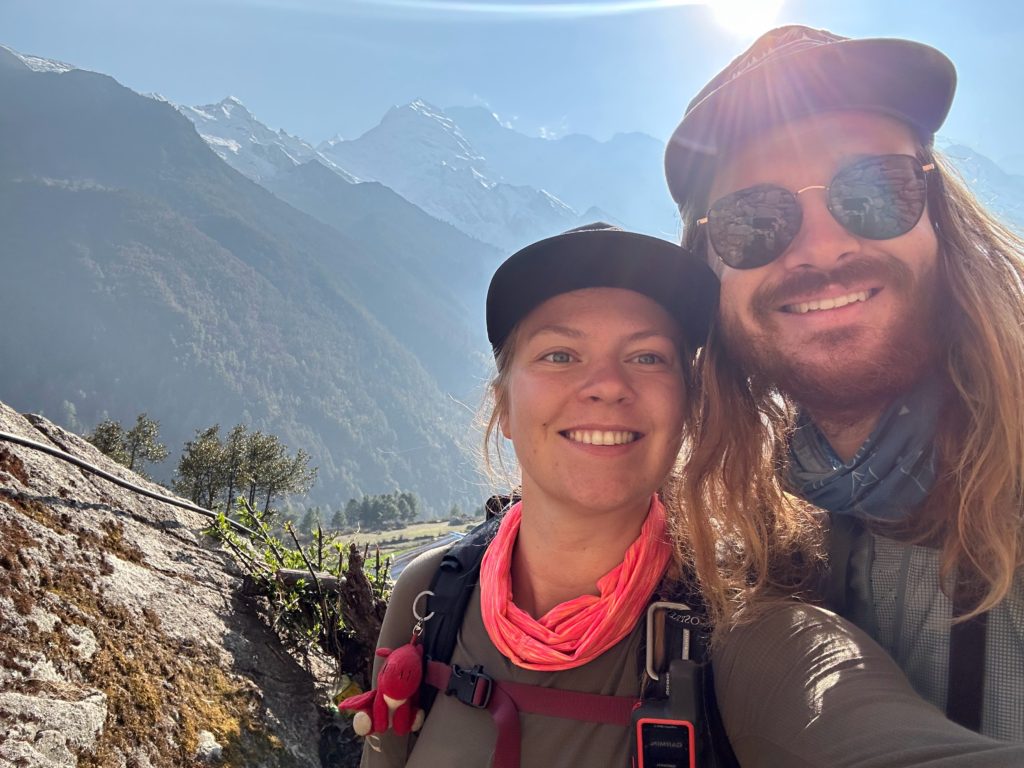


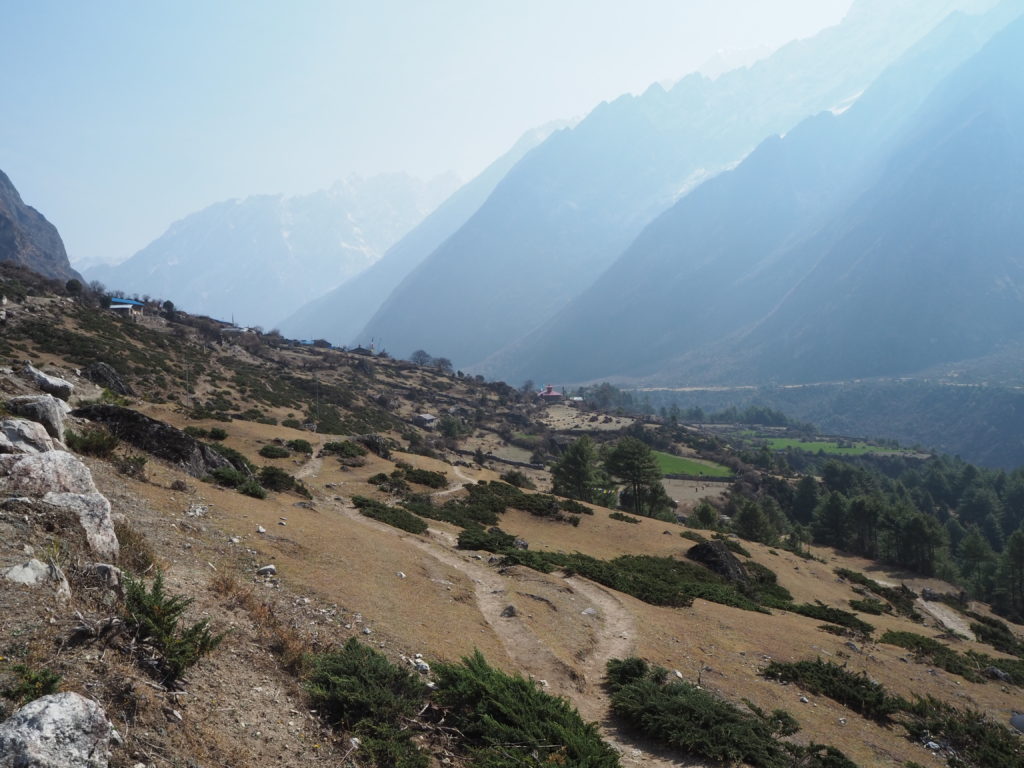
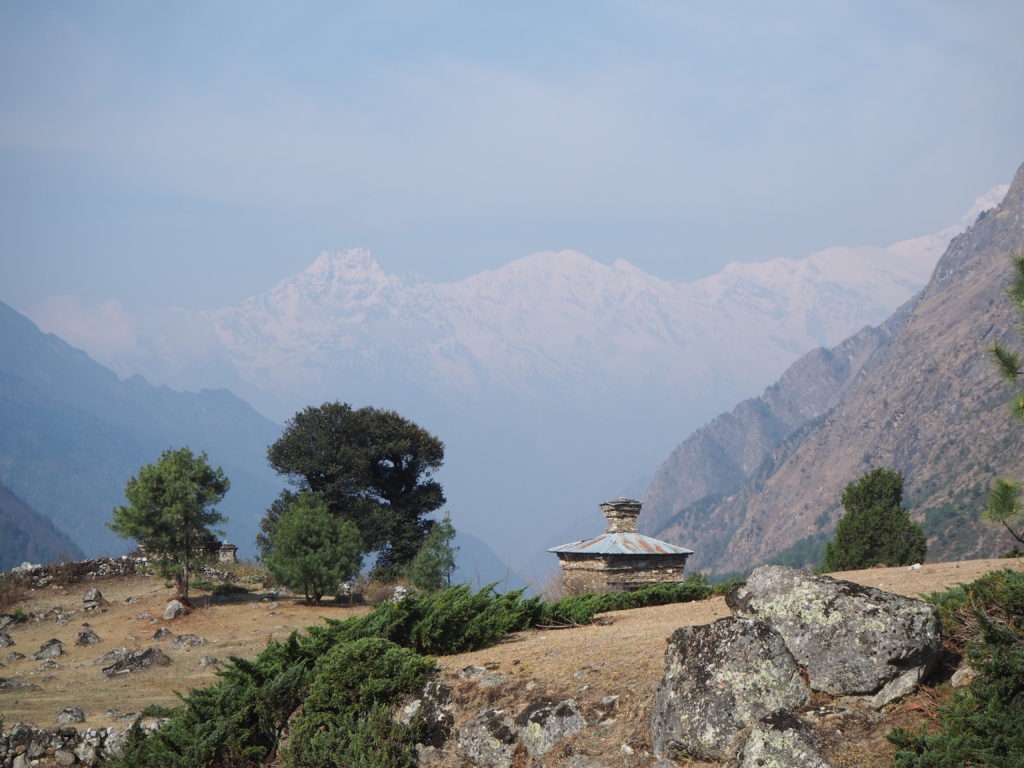
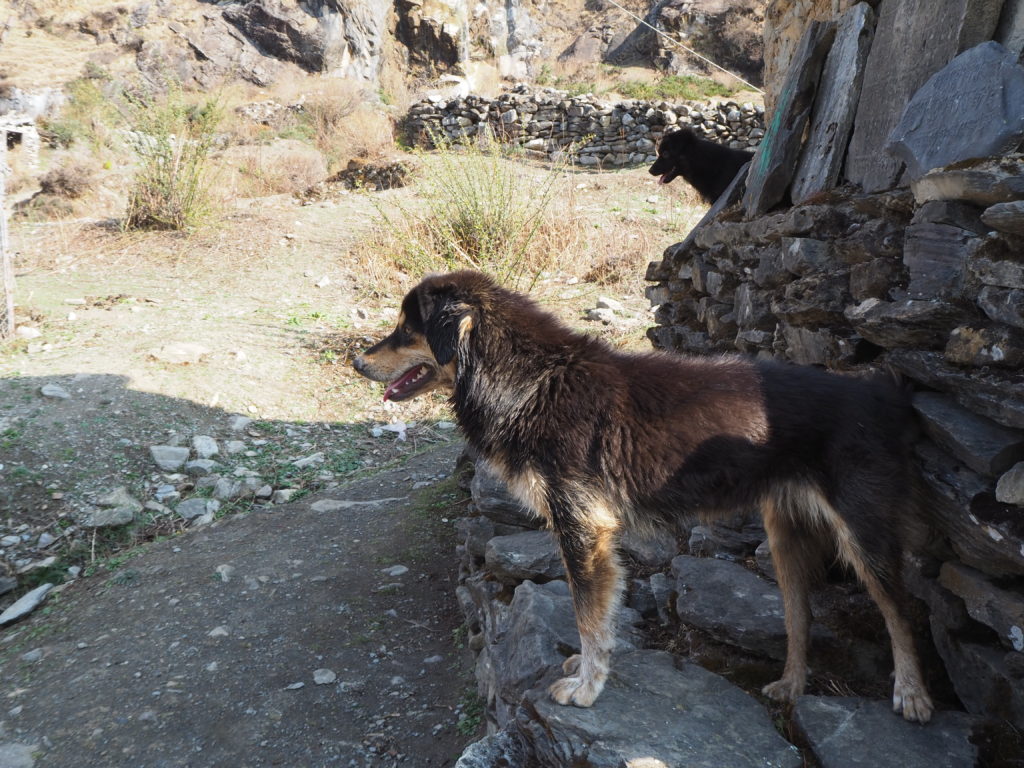


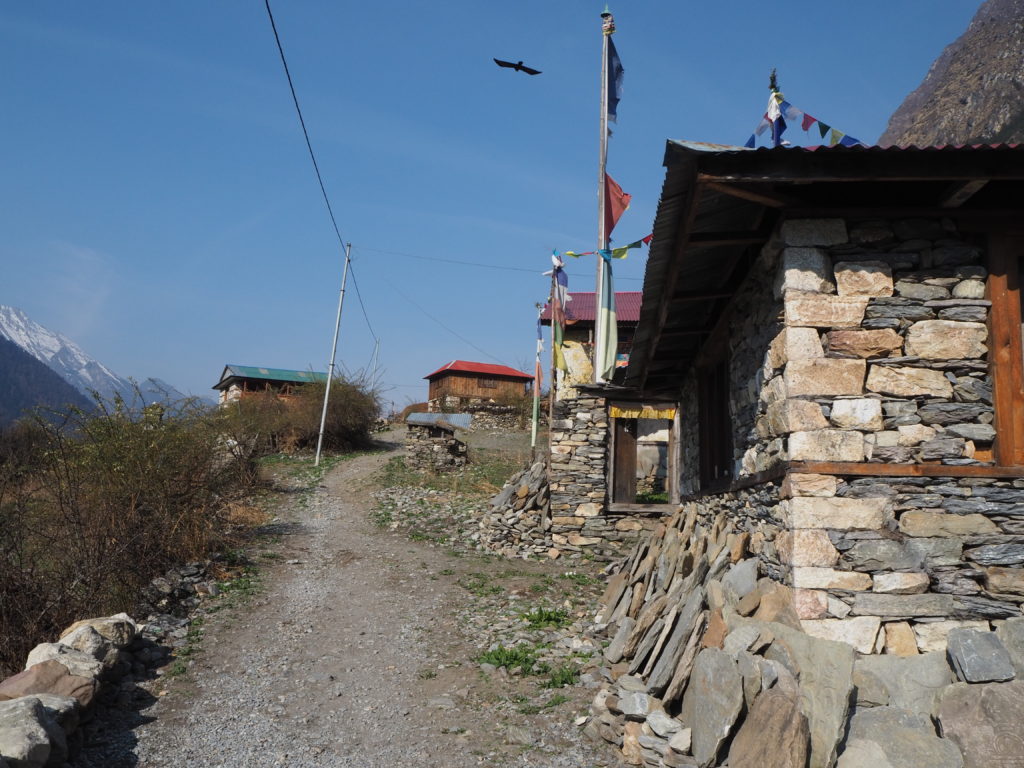
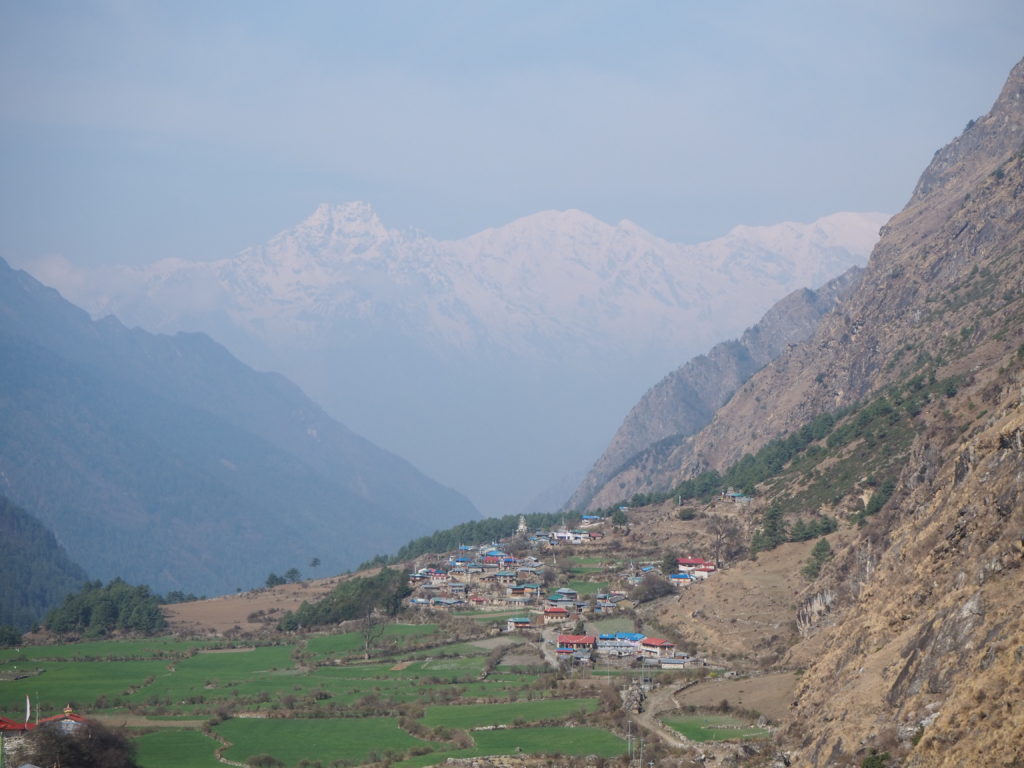
We went to our first monastery as well today. The Tsum monastery, which recently opened in 2019. We were allowed inside of the walls, and witnessed a groups of toddlers playing in the courtyard. The temple was on the far side, where monks were chanting indoors. Surrounding the courtyard were many rooms and residences, all made out of stone or concrete. This monastery survives off of private donations.
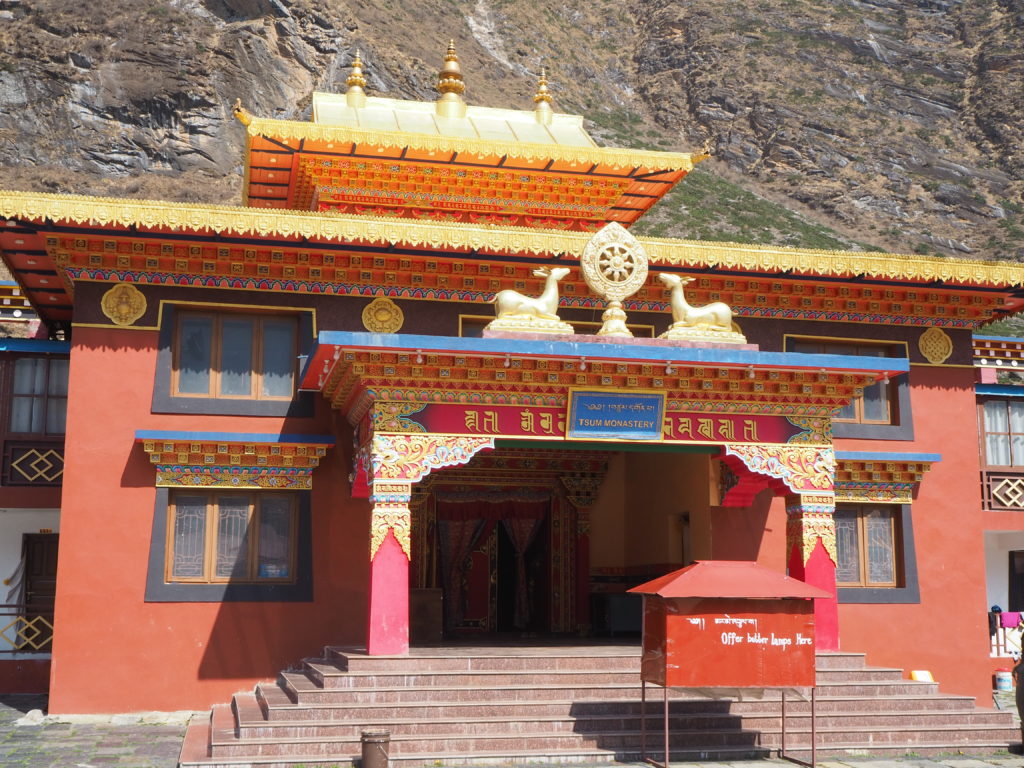
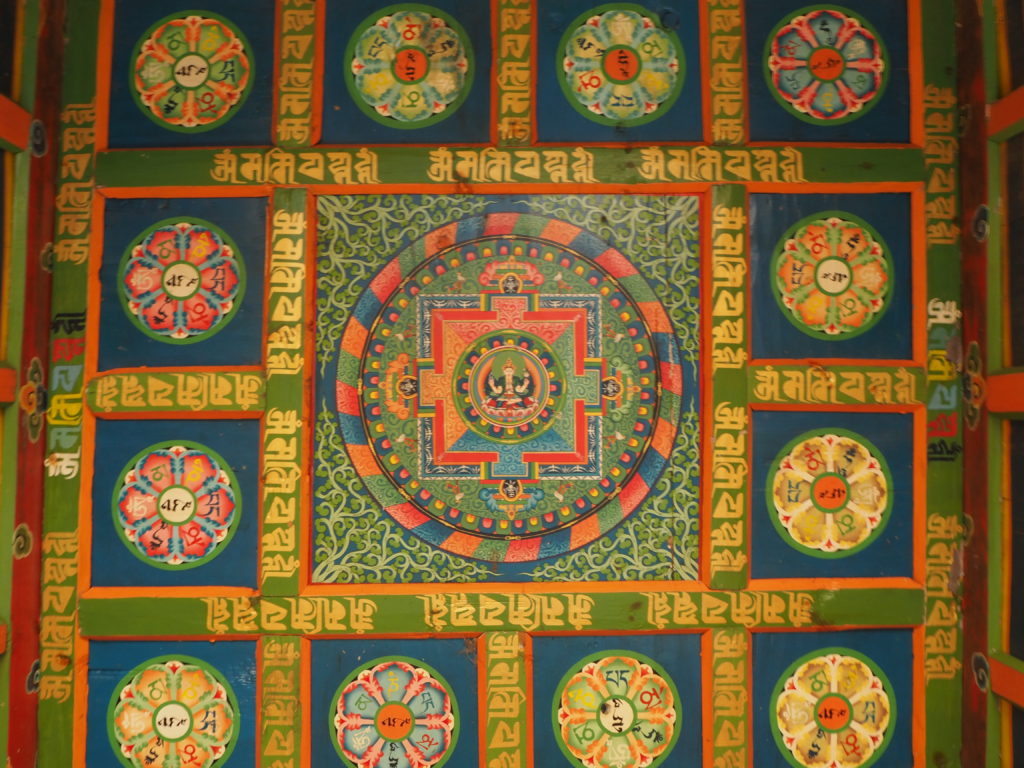
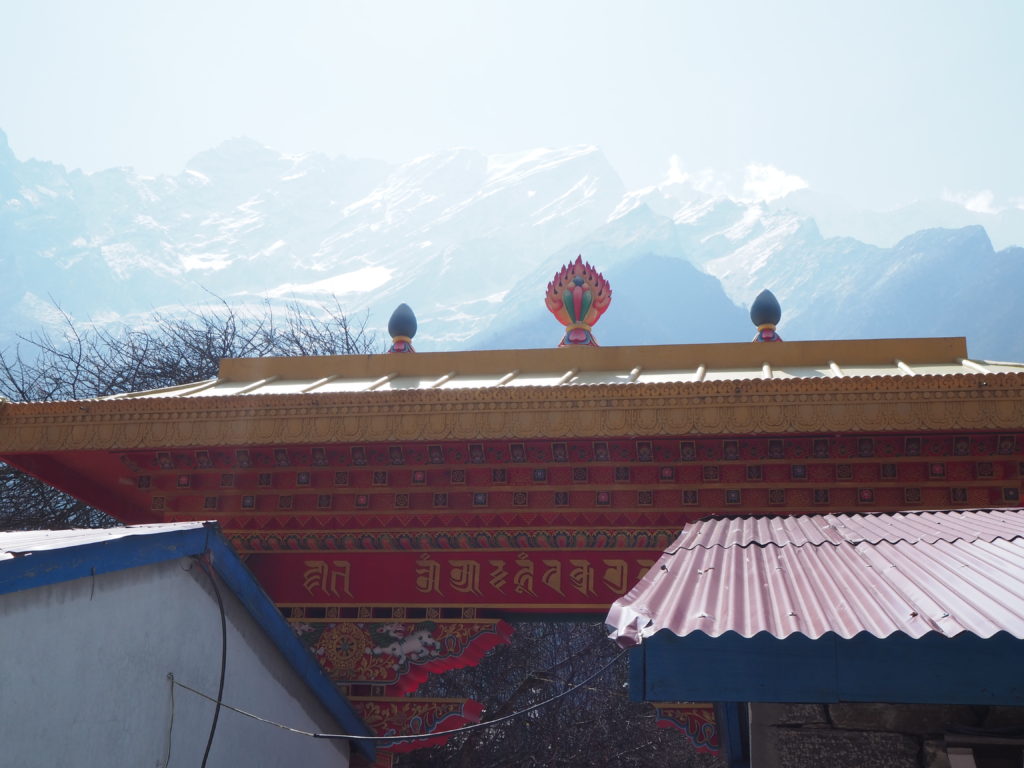
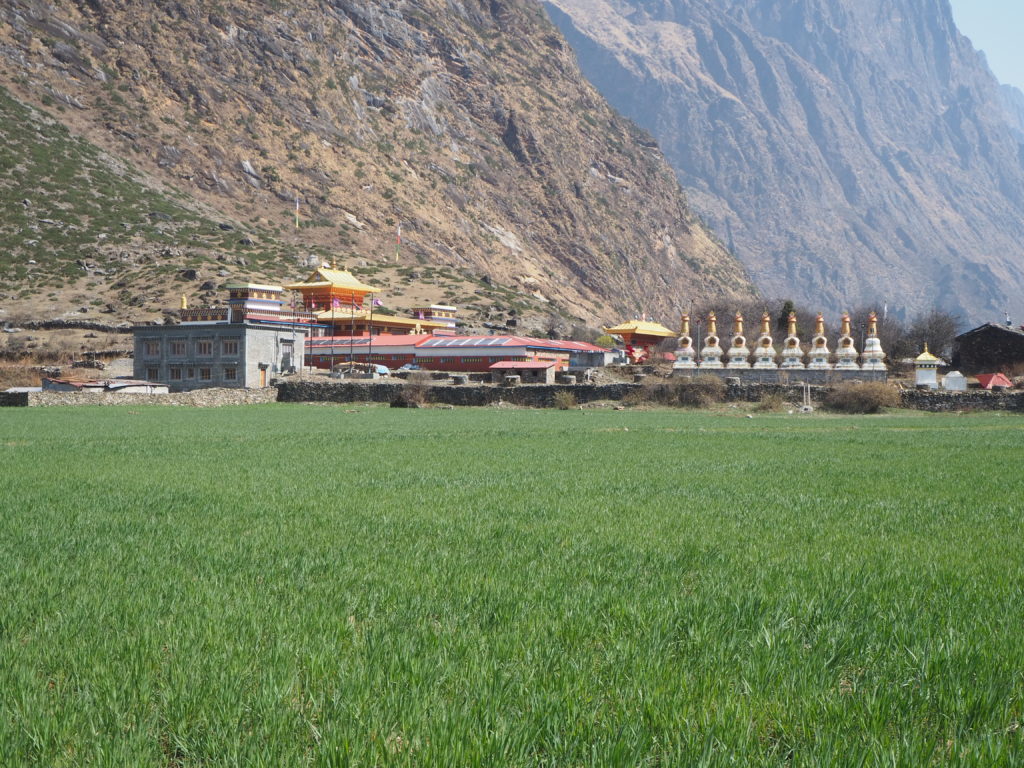
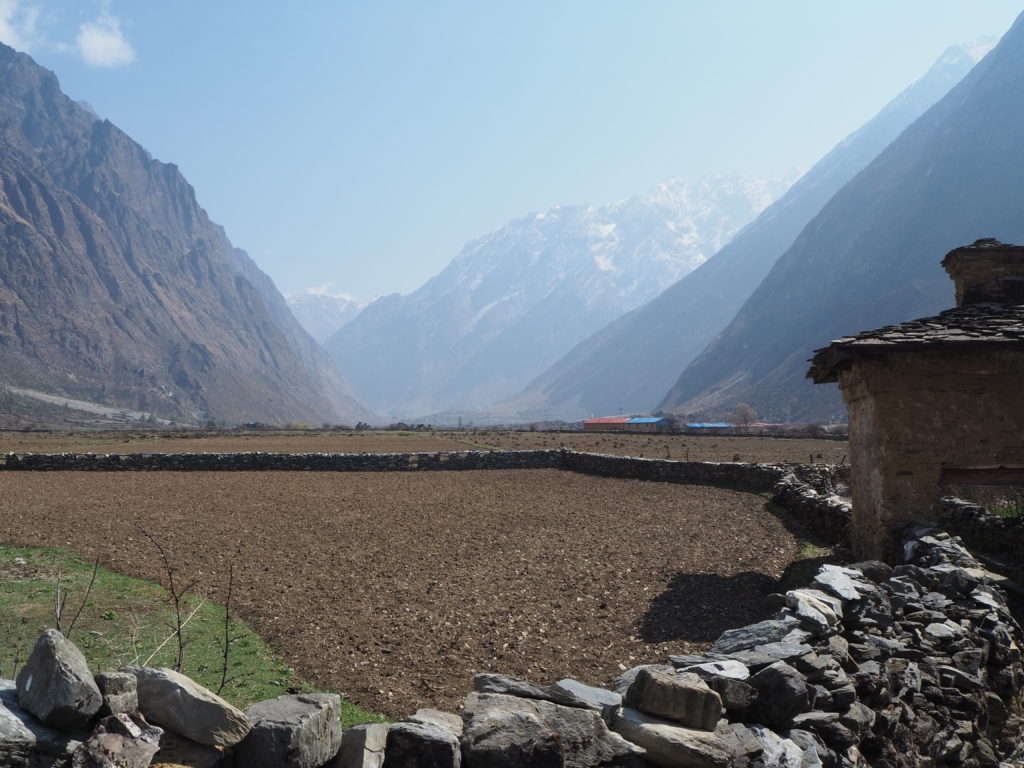
We stopped for tea near the end of our journey at a farmhouse. Hari seemed to know the owner of the residence. He has been a trekking guide for 15 years, and has spent most of his recent expeditions in and around Manaslu. So he knows everyone.
We were enjoying our tea, watching the cows graze along the path, when our host decided that they should be penned in. She started herding them towards the gate, but they were reluctant to move. Her husband and son joined in, and they gestured to me to help. Not knowing what to do, I stood on one of their escape routes, repeating out loud the sounds that I was hearing the woman speak. Chu! The cows were close to the gate, when they all decided to revolt and bolt down the path. We all scrambled out of the way, and had a good laugh.
We made it to Nile in good time, on the best pace of the trek so far. It is a lot easier to go fast when you are going flat, and not uphill. We had some thenthuk for lunch, which is a wide noodle and potato soup. It is a very hardy meal, and filled us up nice. We also had the coldest shower of our lives here. Julian made it up, which was good news. He took his time, but made it before the wind picked up. The afternoons get really cold this high into the valley.
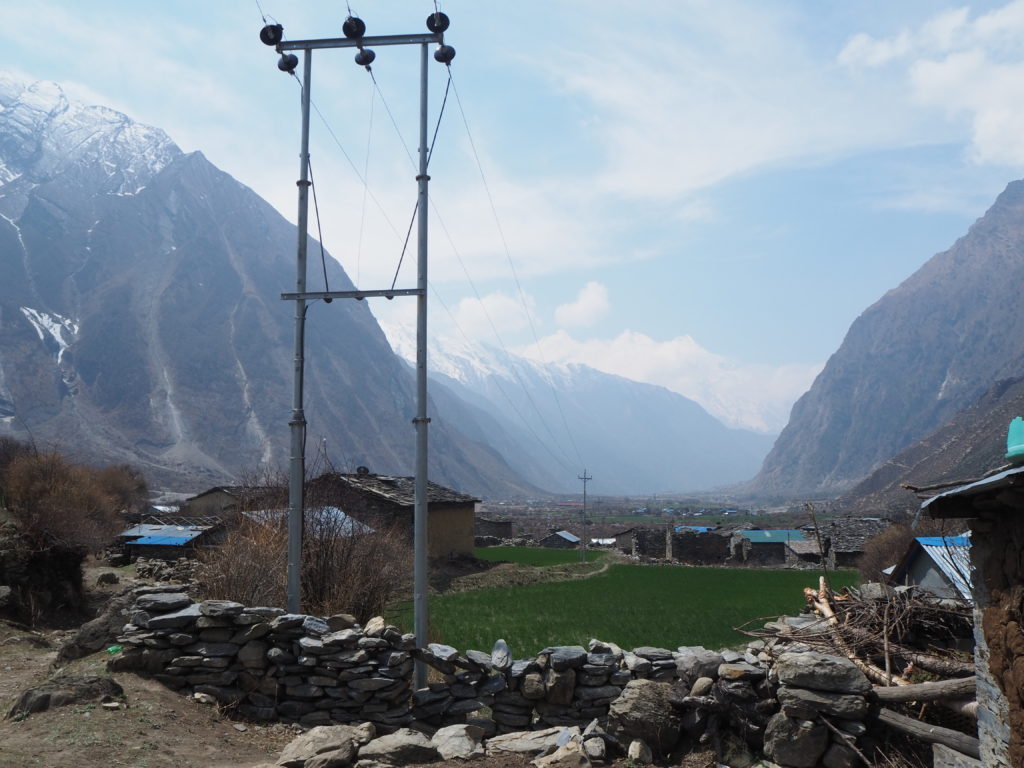
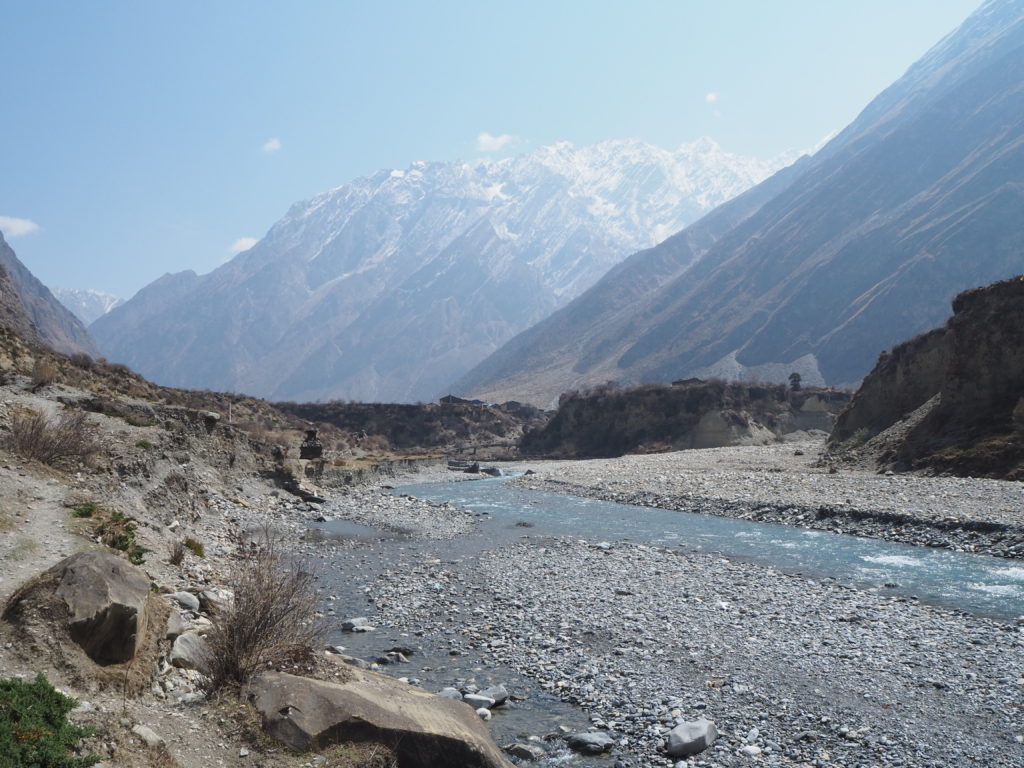

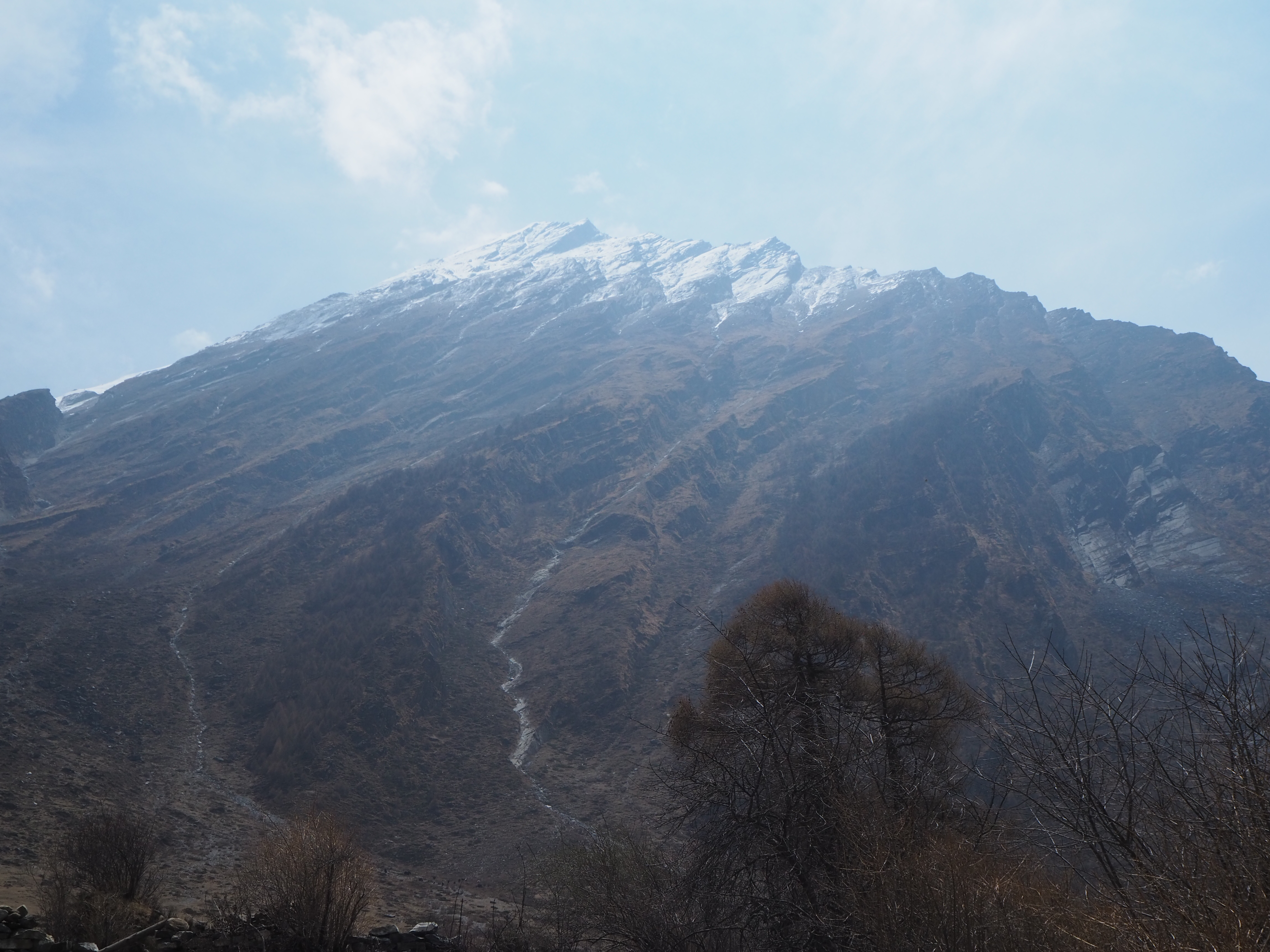
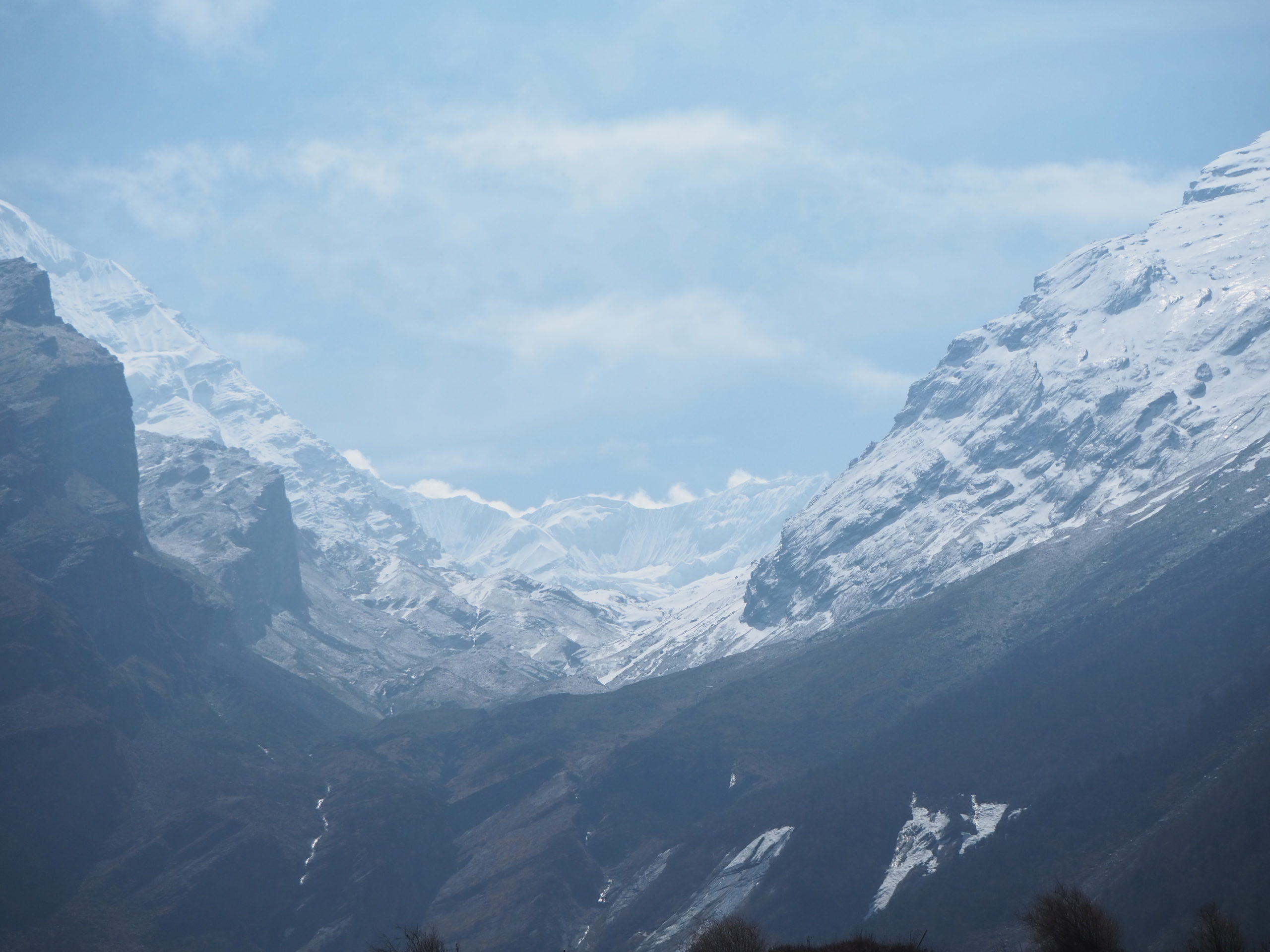
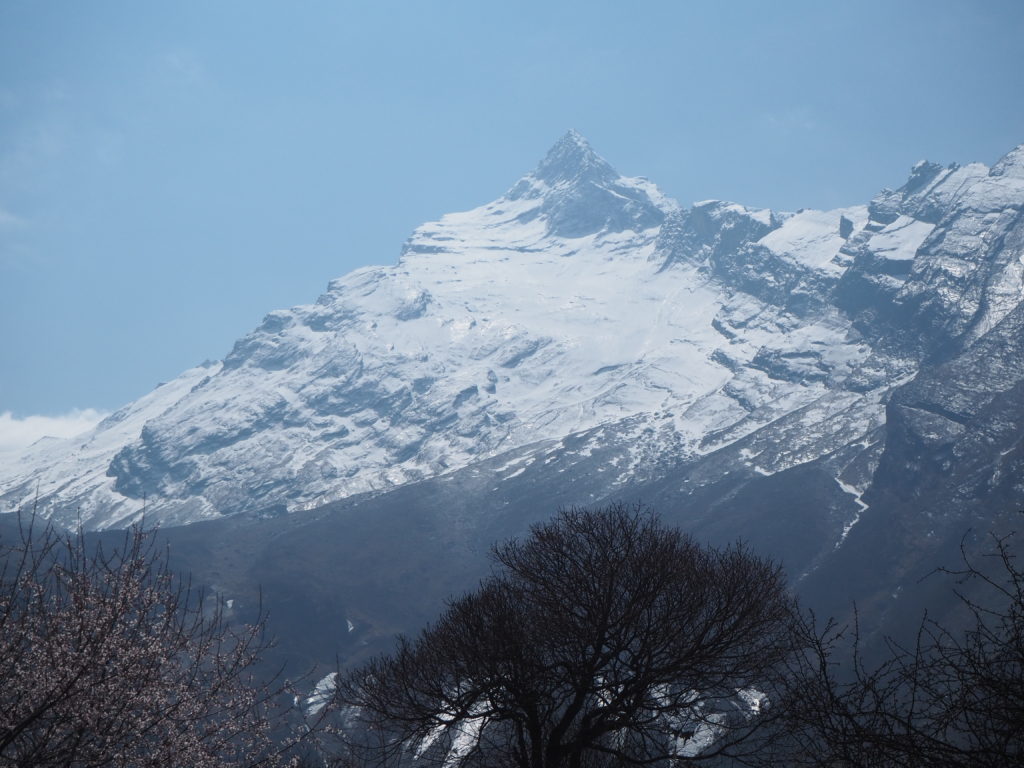
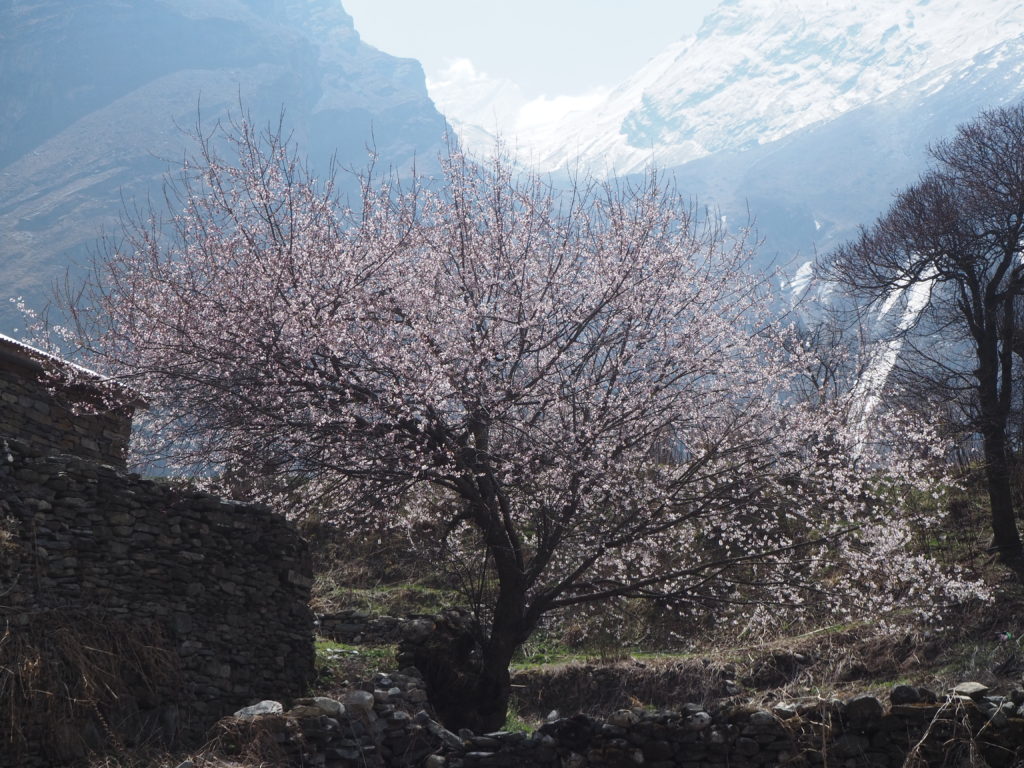


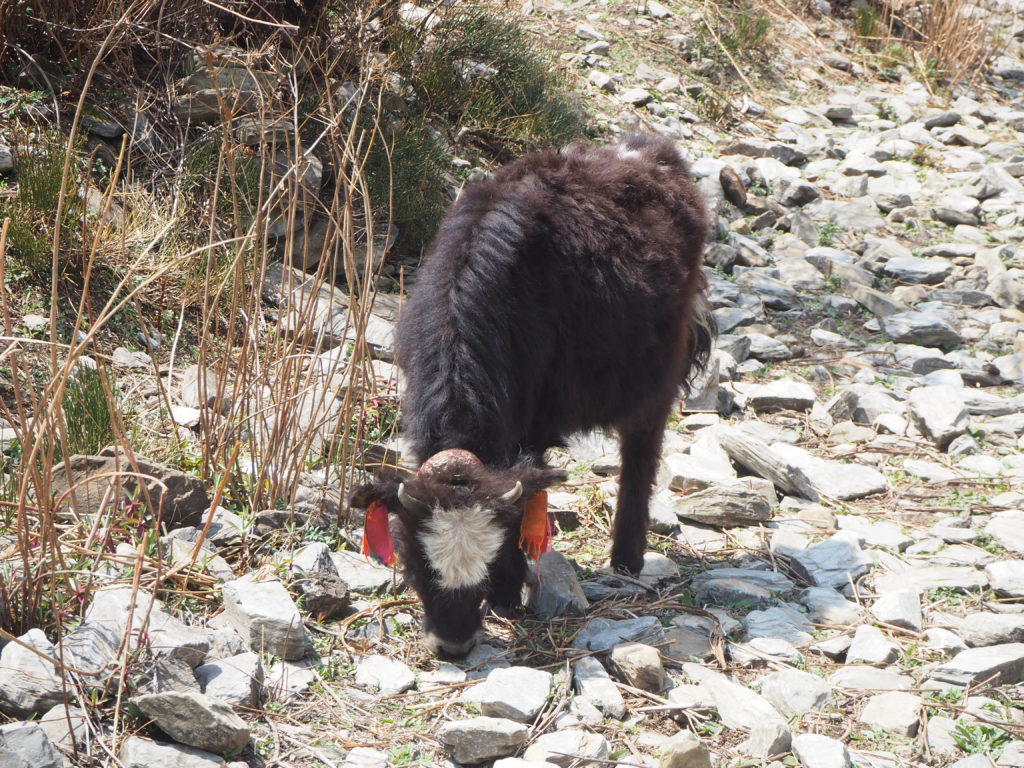

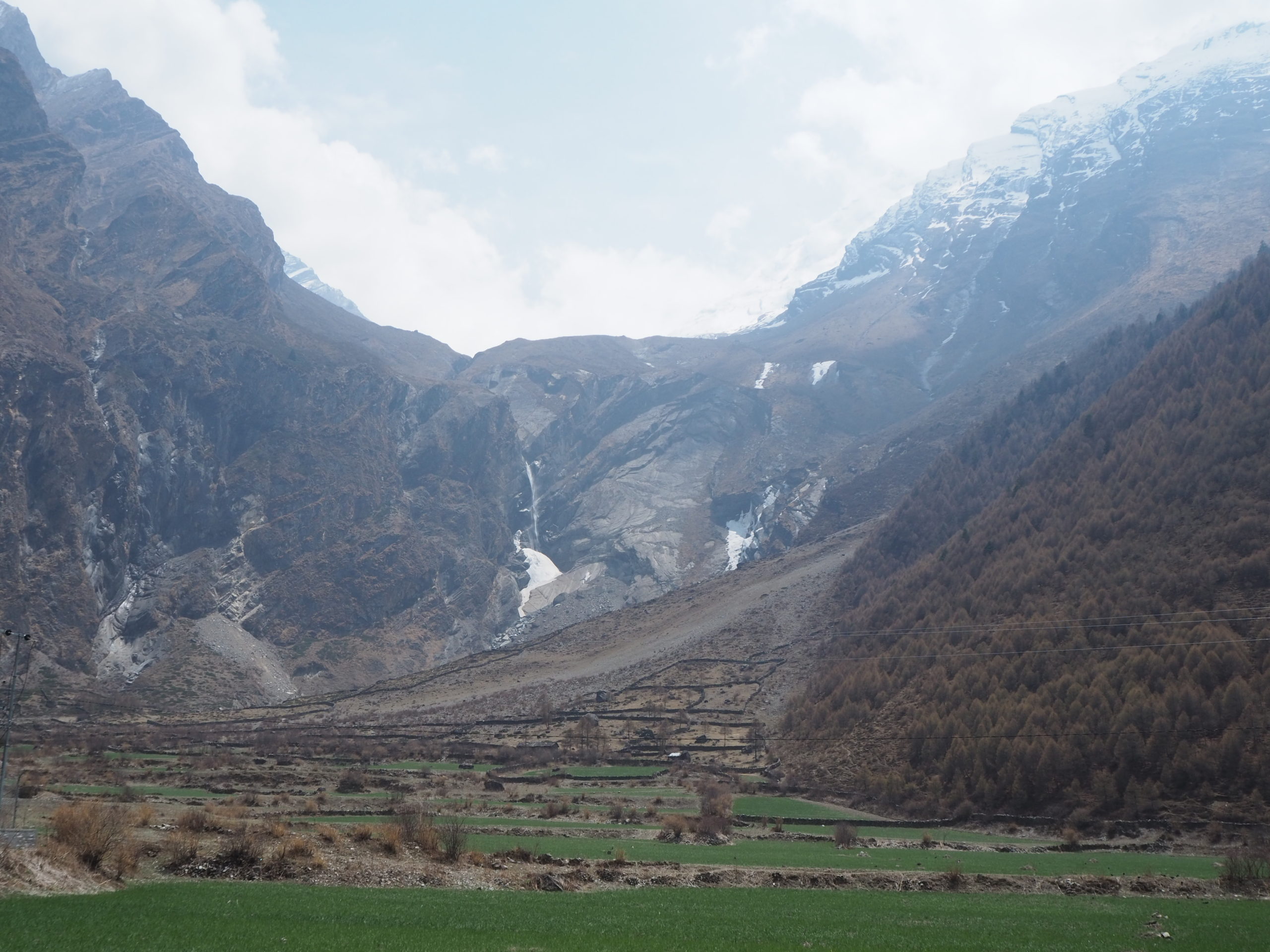
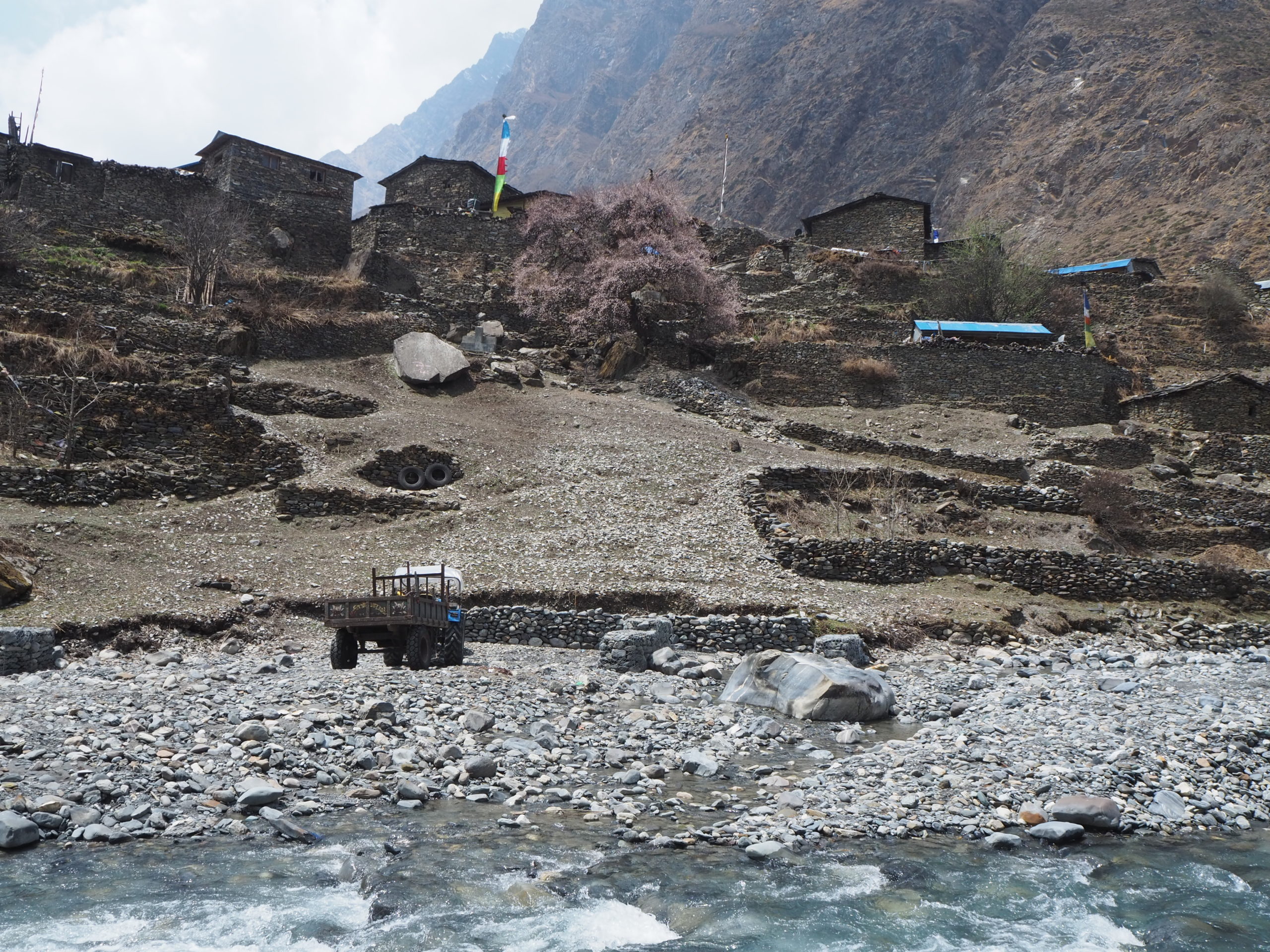


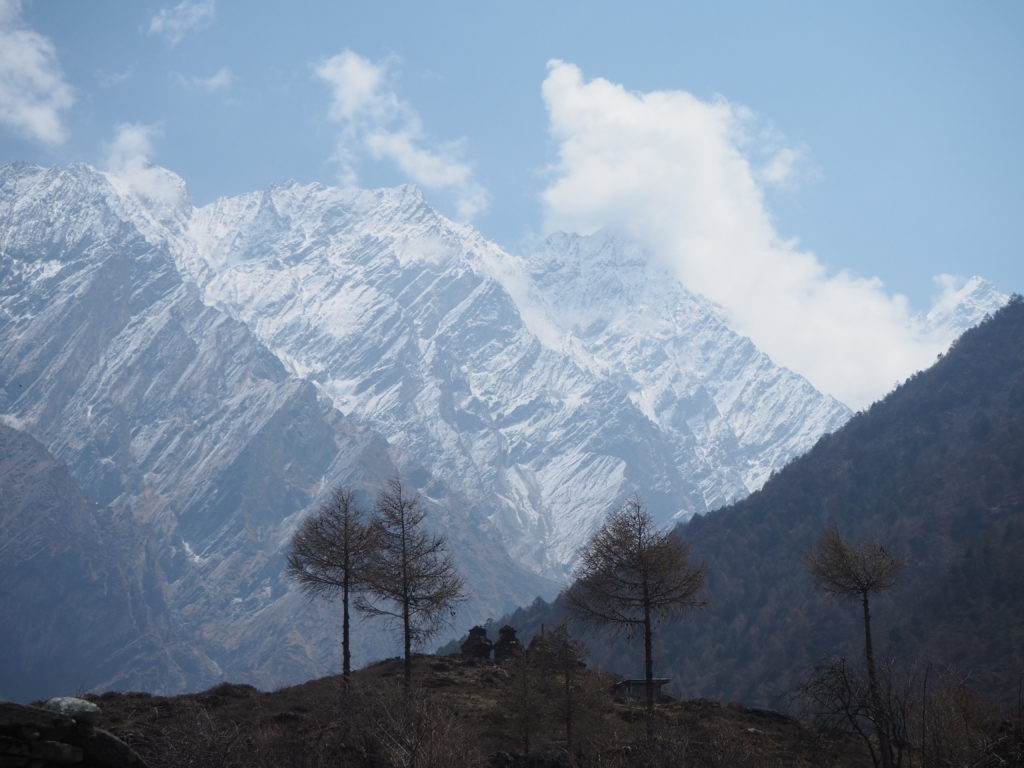
Day 6: Mu Gumba Day Trip
Length: 11.02km
Elevation: 2240m
The morning was a bit frosty, but very lovely. Cam woke up with a bit of a funny tummy. She thinks she overate in Chumling, and now with a little more altitude, the chickens are coming home to roost. But she was still fine enough to walk. Julian however, was feeling down again. After a second night of no sleep he decided to head to lower elevation to try and figure out what was going on. It may be a physical thing for him, but trekking is half a mental game. Once your in a spiral, its hard to get out of it.
Due to the nature of the day trip, we got to leave everything in Nile and walk without packs. It was really relieving, especially for Shubus, who got a nice day off. He still came up to Mu Gumba. He had never been in the Tsum valley before, and was taking it in with the rest of us.
The walk got off to a bit of a strange start. In Nile, the pathways are all lined with stone fences. These gate off people’s yards and farmland. A bunch of dzo (a hybrid between a yak and cow) were chilling in these pathways like they were waiting for the bank to open. With our newly acquired herding skills from the day before, we shepherded them out of the town into a field so we could pass. I was using the chu! sound (after observing its use the day before), while Cam had settled for the humourous mooooooove. With the dzo out of the way, we could moooooove on with our day hike.
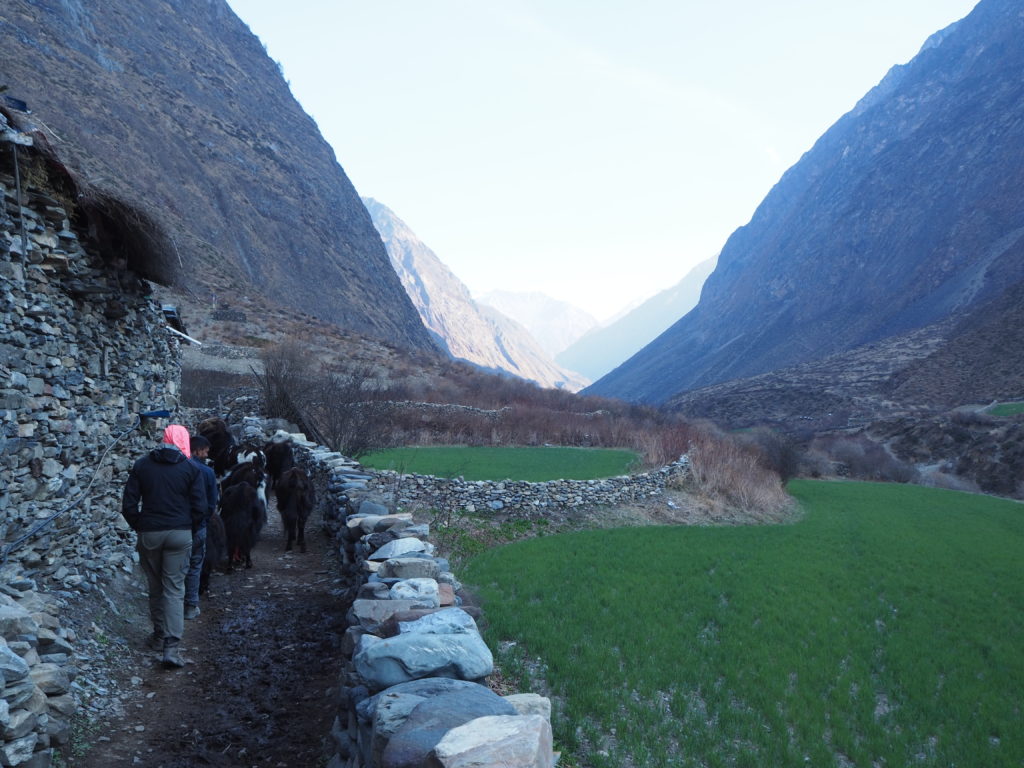
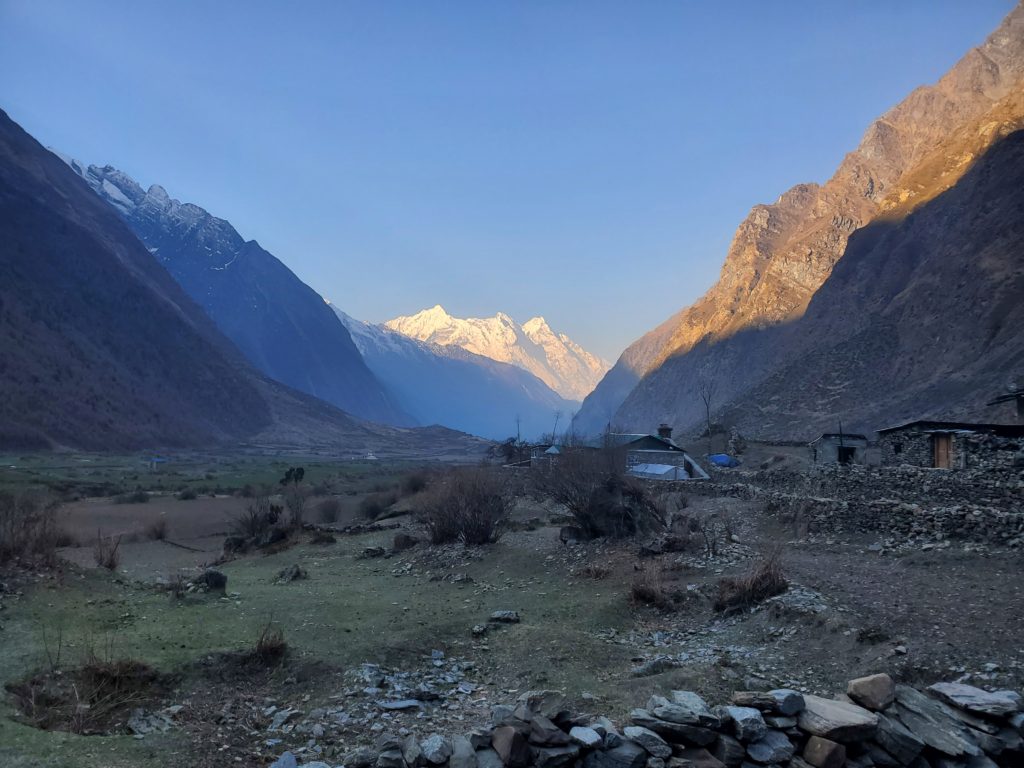

The pathway was an easy one to traverse. It was wide and relatively flat. No major cliffsides to be concerned with. So we walked along and chatted, observing the world around us. Here we were well above the treeline. Junipers were no longer on the ground. Instead, it was a sloped grassland to the river. Dzo, horses, mules, and everything else were enjoying the free pastureland that this provided.
Across the river there was another pathway, and we could see a bunch of cows getting shepherded up another valley. Apparently there are wonderful pasturelands up that way, but we could not see them.
As we moved up the valley, small cliffside monasteries would pop into view. These are generally built into cave faces. The reason for their existence in this remote valley is quite sad. A long time ago, the monks used to practice in Kathmandu. In a bout of religious fury, a group of extremist Hindu’s took arms to the home monastery, destroying it. The monks and nuns then fled into the mountains, to be able to practice in peace.
These monasteries had no pathway to them. Instead, to access them it is a scramble up a hillside to the front doors. They are all part of larger congregations based in Kathmandu, and are funded from their parent monasteries. They also rely on the local population for fresh foods, and on donations from travelers passing by for sustenance.
The higher we got, the more the mountain landscape changed. New, taller snowcapped peaks would peek out from behind their shorter, closer counterparts. They offered incredible views to witness. We spent a lot of time turned around, looking down at the valley we had come from, and the magnificent multi-tiered landscape below us.
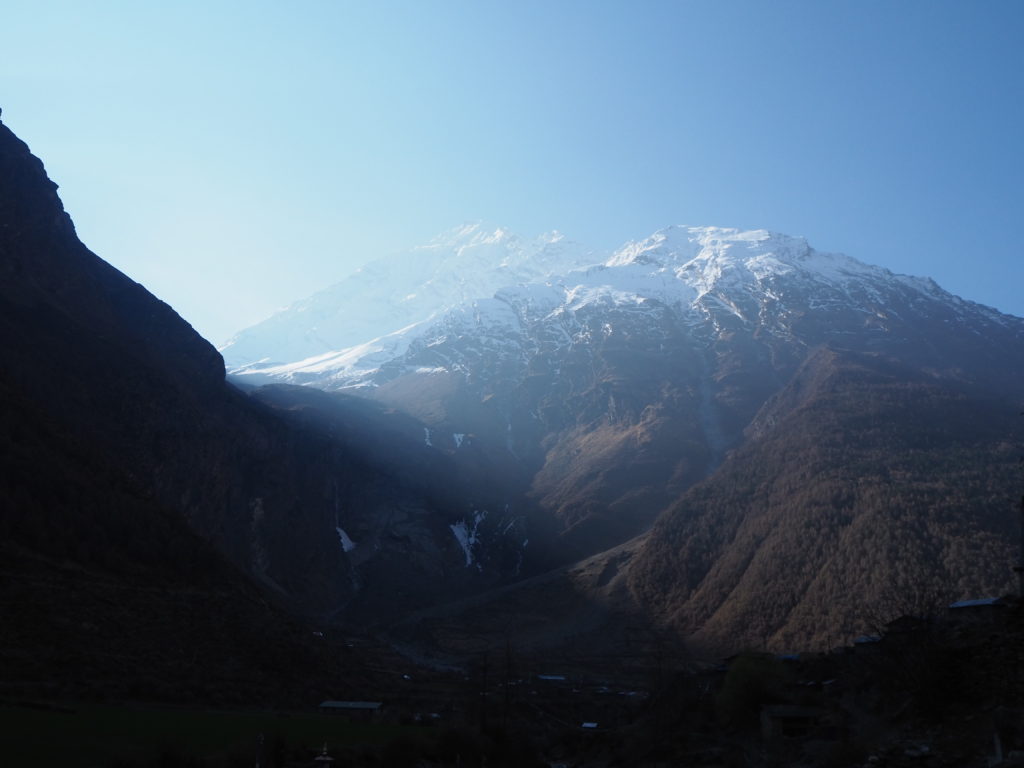

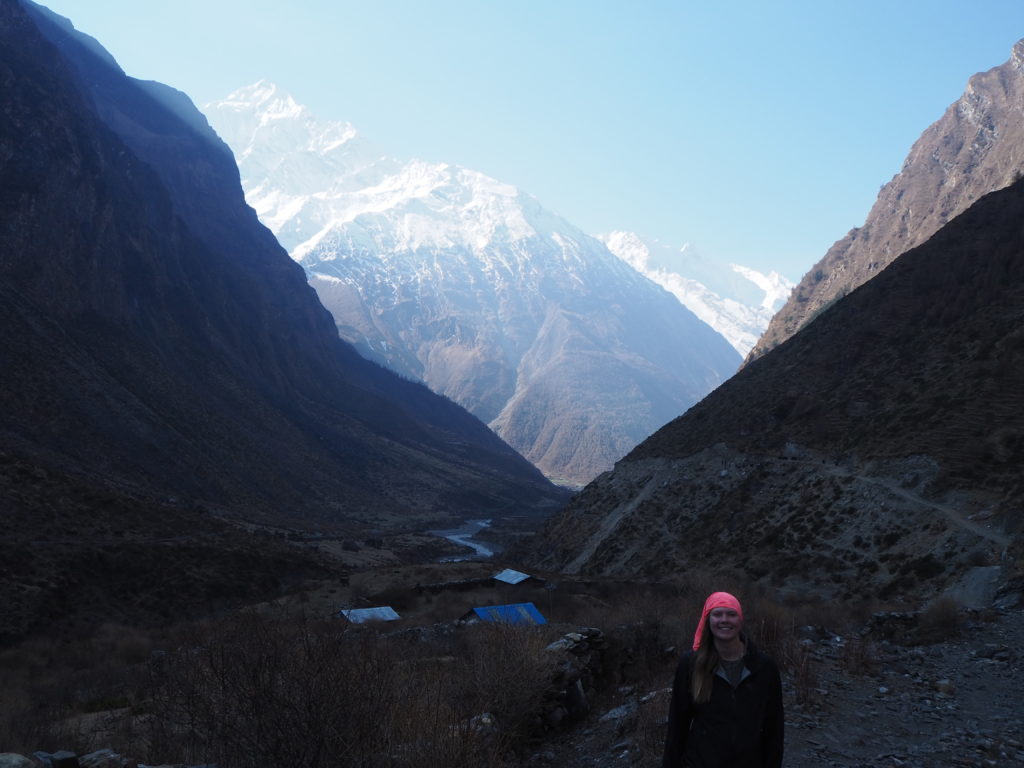
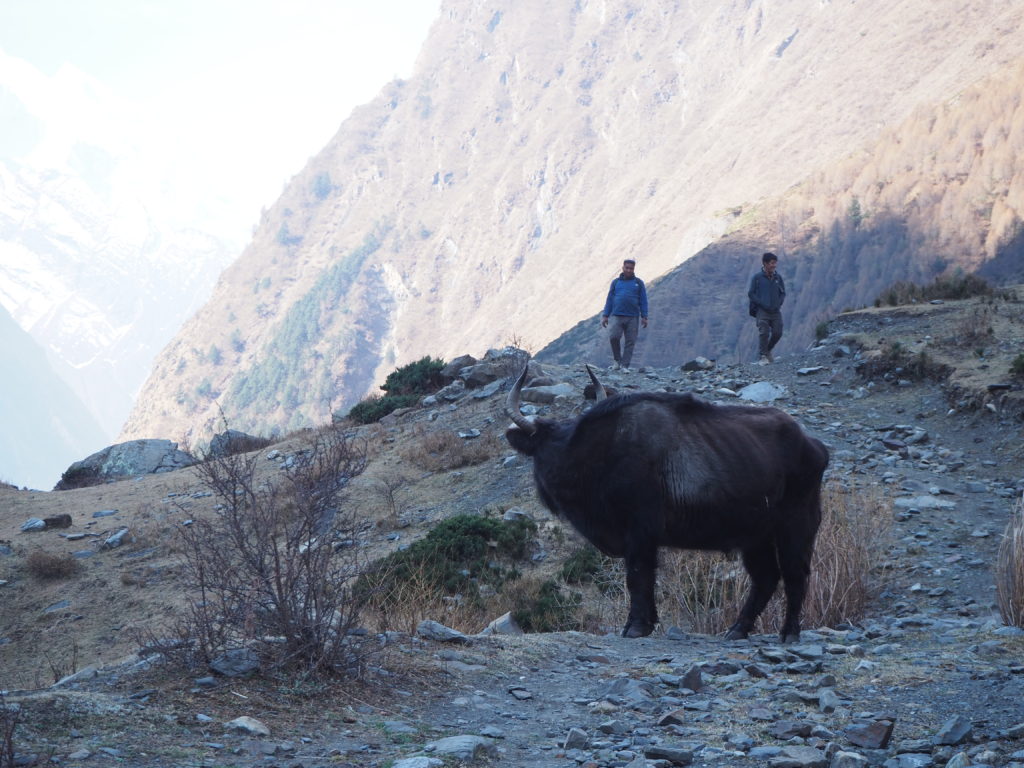
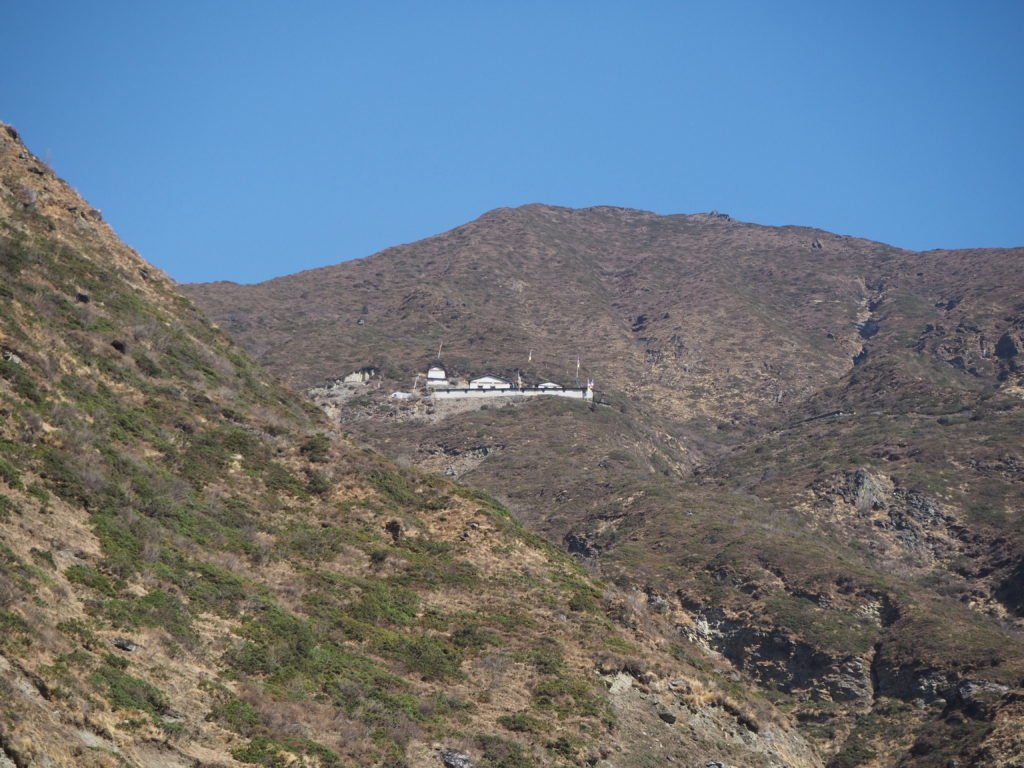
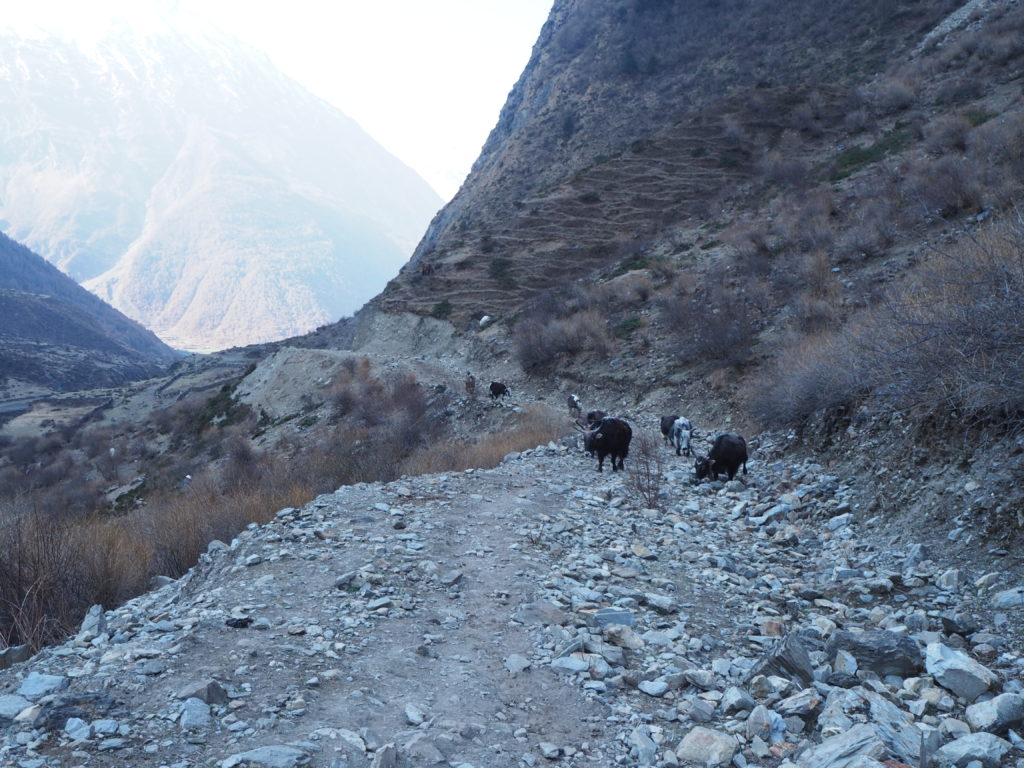
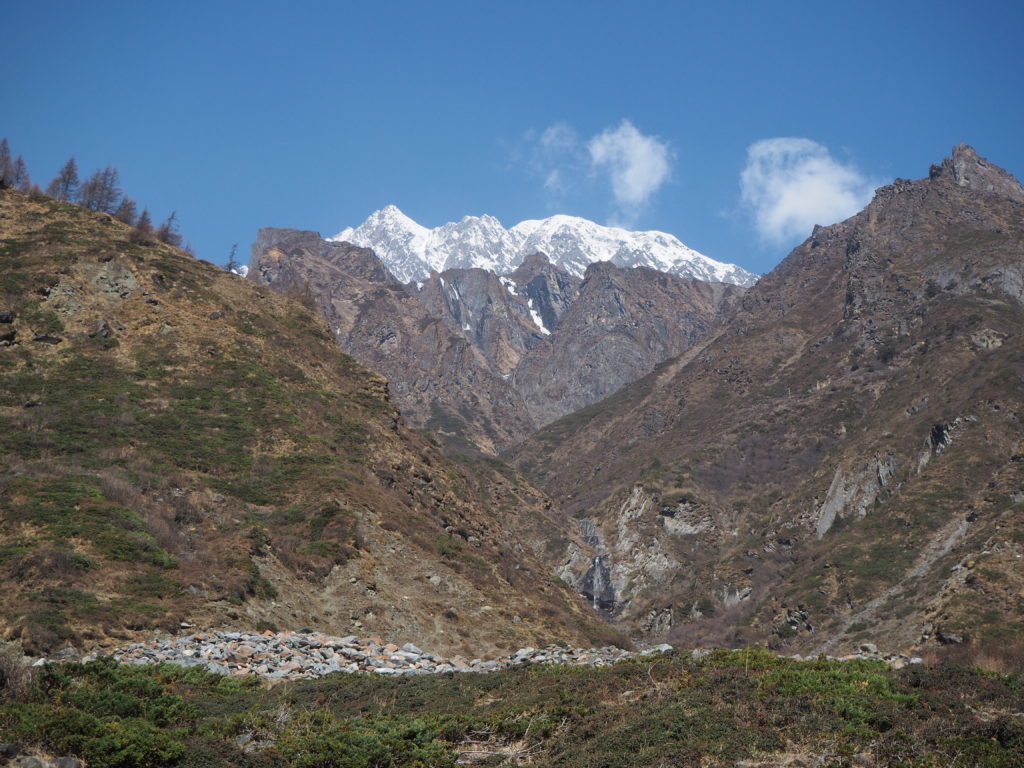

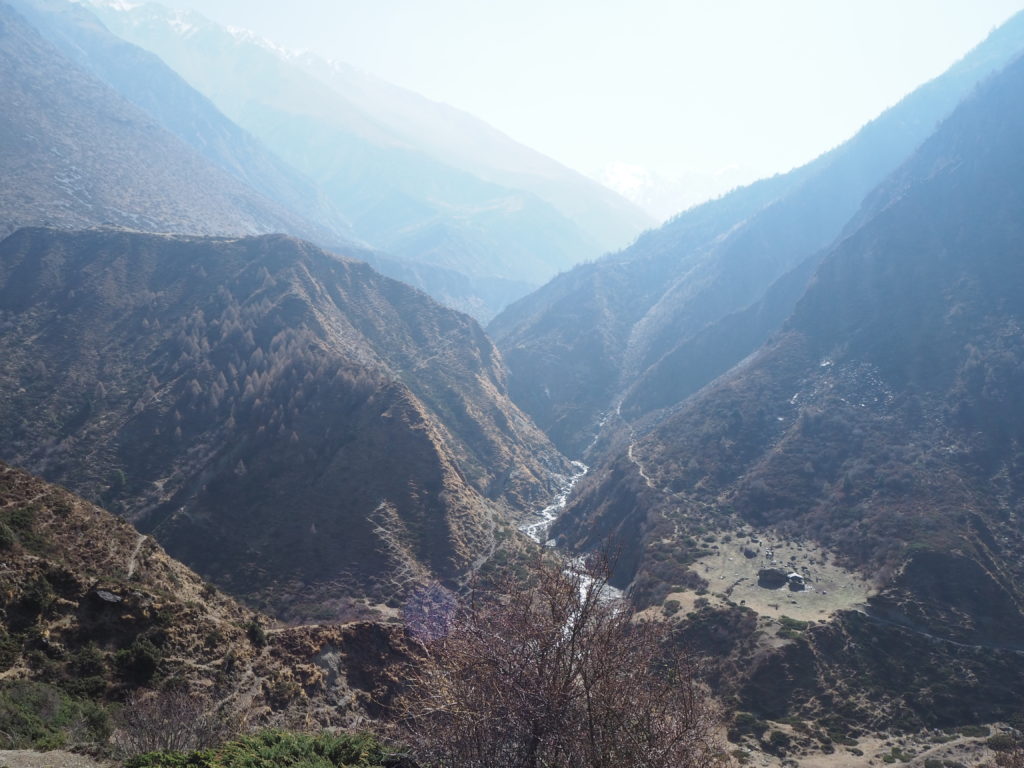
Mu Gumba came into view. This is another monastery, but is much larger than the hillside ones that we had passed. It had a path to the top, no doubt created by the daily arrival of tourists using it as a lookout. It is generally the highest point reached by foreigners in the Tsum Valley, and we are no different. There is another village beyond Mu Gumba. Beyond that is only 5000m passes to Tibet that are closed by the Chinese government.
The monks are welcoming to the visitors. Four live there at the moment, and we met two. They were elderly gentlemen, but very kind. We were the first group of the day to arrive. One monk gestured to me if I wished to see inside the temple. I obliged, removed my shoes, camera and hat, and entered (the hat is optional, and is my western custom carried over. Generally, photos inside of temples are prohibited). Inside was a dark cluttered wooden room. There were portraits of the Dalai Lama, and other figures who I could not place. Tapestries and flags hung down from the roof. Benches and robes filled up the floorspace. I left a small donation in a little box. The box was stuffed with money though. I don’t think they need money at the moment, or they lost the key.
The Mu Gumba complex was quite large for just four monks. There were residences for up to 30 (I’m guessing) to stay at a time. The buildings worked their way up the hillside. Kitchens, and all sorts of other rooms we did not explore must have been in the area. Mu Gumba is a lesser known pilgrimage site in times of the holidays for other monks. The highlights were the pavilions, and the mountain views that surrounded it.
We must have spent near an hour sitting on the steps of the temple, taking in the small details of the mountains around us. There was the magnificent view of the Tsum Valley below, with Ganesh Himal II’s (we think) north face commanding much of the sky. And to our east was another set of mountains, with a wonderfully symmetric downslope away from the main peak. Hari and the monks were chatting away, along with some young Nepali tourists who had joined us for the day.
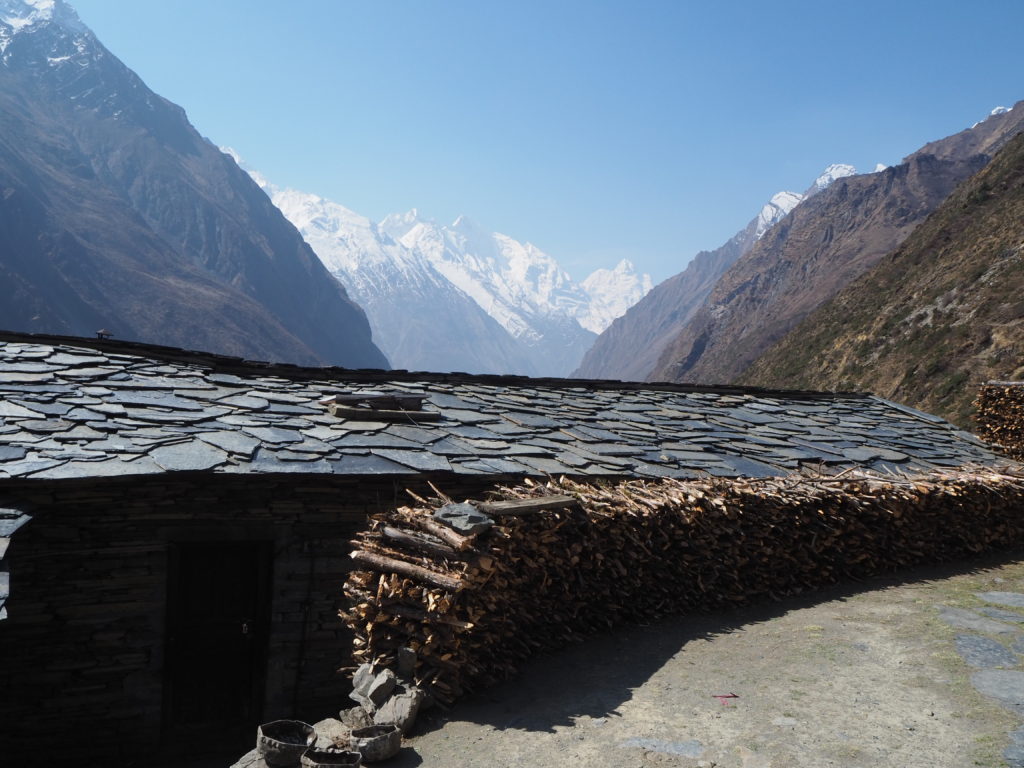
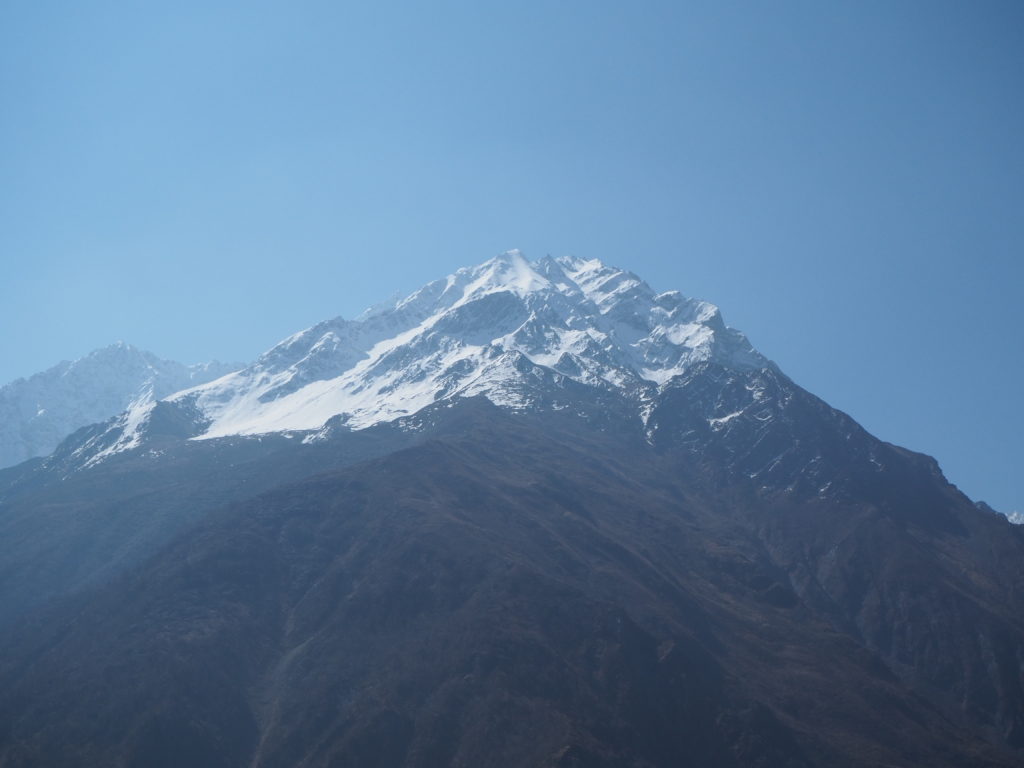



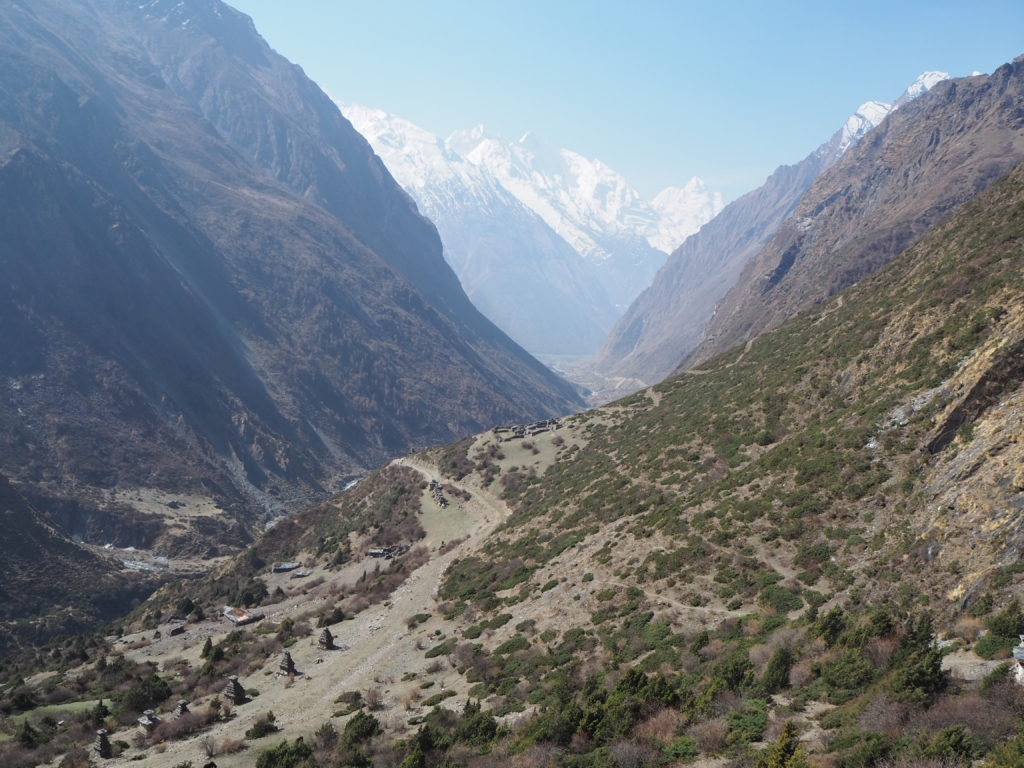
Sadly we had to depart, and we made our way back down to Nile. We encountered another group of dzo at the entrance, but with our now expert herding skills, they proved to be less of an issue.
We had the choice to continue on back to Chhokang Paro for the afternoon. The point being to save a day of hiking on our way to Gumba Lumdang. With Cam still not feeling the greatest, we decided to chill out in Nile for the afternoon. We said goodbye to Val and Ilona, who decided to make up the extra ground.
To our surprise, no other tourists came up to Nile for the day. The night before was very busy. It was only ourselves and a Czech photographer (who had been hiking the same route as us, but generally kept to himself), staying the night. So we hung out in the main room, and the kids would come and bug us. One little girl was full of energy, and we were naming the flavours of the candies she had. If you don’t speak the same verbal language as a kid, you can communicate in sound effects and peekaboo games. We had good fun, but she had more energy than us.
Her older brother, Chinling, who was 10, played cards with us. Hari taught hum Dhumbal, and he picked up on the game pretty quick, but not the strategy. Not like we have any idea what the good strategies are yet. Maybe by the end of the trek. He communicated in basic English to us, fluent Nepali to Hari, and fluent Tibetan to his parents. We were amazed at how even 4 days from the nearest road, he was well on his way to being trilingual.
There is a focus on education for the younger population in Nepal. The few university aged locals we meet always tell us about how they wish to apply for school in Canada because we have good education and good jobs. One has lamented about how there is nobody around his age, as they have all moved away. He then told us about his siblings in the UK, Ohio and Washington DC. He wishes to stay at home to take care of his parents, but is still studying aerospace engineering. The pursuit of education is affecting the mountaineering industry in a strange way. There are very few young guides and porters willing to work on Everest and similar massive mountains, due to the safety risks. This will cause a shortage in the next 10 years. The effects will be interesting to see.

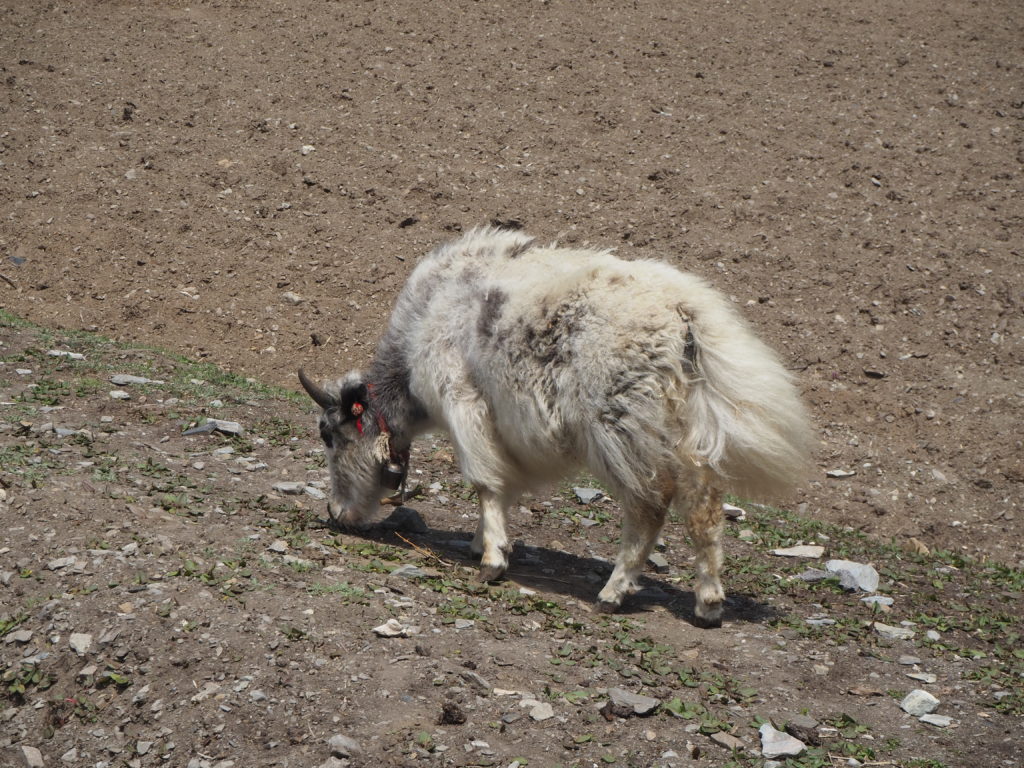
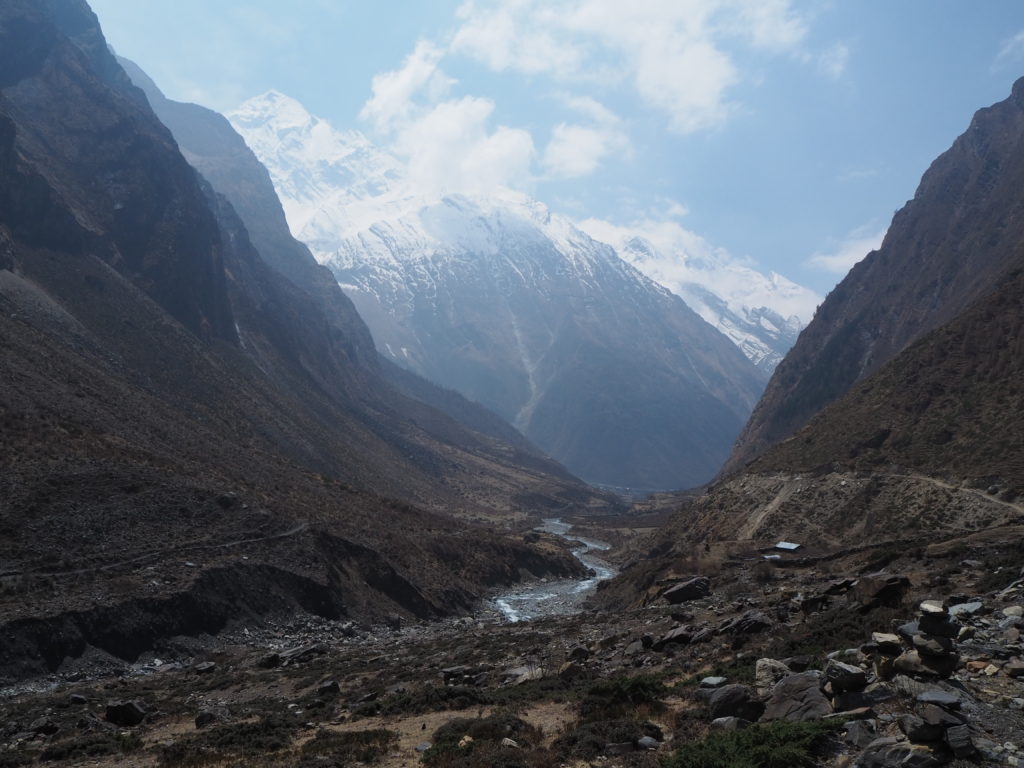
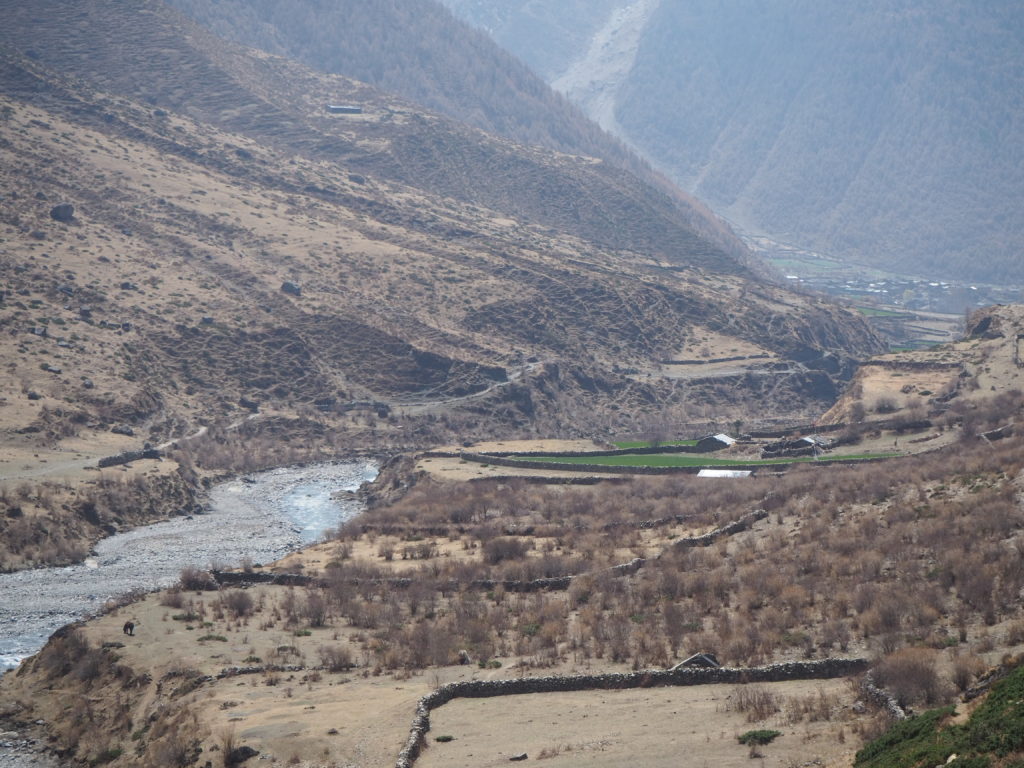

Day 7: Nile to Gho
Length: 15.56km
Elevation: 310m
This was perhaps the simplest hiking day so far. It also was an important one, as this was our 10 month anniversary of departure from Calgary. We would be heading back down the Tsum Valley, retracing our steps to a convergence, where we will be ascending another valley the day after. The morning was unfortunately foggy, and we could not see the mountains down the valley. This fog persisted throughout the day, and the magnificent painted mountain scapes we had hoped to look at all day were nowhere to be found.
Hari took us across the river from when we had arrived to Nile. This gave us some different views to look at. Lots of steep slopes with spiky tops, and the fog hiding the bigger behemoths behind them.
We took our first rest at a recently made stupa. The location seemed to be arbitrability placed in the valley, between a couple of towns. It was painted very beautifully though. The prayer wheels on the outside were spinning due to a hydraulic system from the nearby stream. This contraption would constantly emit good luck to the surrounding area.
We also checked out our first nunnery today, Rijan Gumba. This place had gotten a recent upgrade, and they invited me in the monastery to check out the interior. This place was in sharp contrast to the dark, cluttered room of Mu Gumba. Here it was brightly lit, with lots of room. There were still paintings, tapestries and photos of the Dalai Lama and other Tibetan Buddhist figures, but it was all more spaced out. There was also room for prayer for at least 40 nuns.
The compound of Rijan Gumba was massive. In the middle was the start of construction of a future concrete stupa. The exterior had all sorts of residential rooms. The old prayer area sat near the front entrance. Everyone seemed ready to move on to other things, so we left pretty quick.
The walk back was very quick. We made it to Chhokang Paro in 2.5h, which is quite good for 11km and two explorations. It was a nice sunny day, but still foggy in the distance. We had our classic lunches, dal bat for me, and veg egg fried noodles for Cam. She was feeling better today.
In Chhokang Paro we saw our first monkeys of the trek. A nice family was hanging out in the trees minding their own business, and a massive one was jumping between all the trees and houses of Chhokang Paro. We were warned to leave the monkeys alone. They are known to bite. The monkeys move with such great agility, between all of the elevated perches.
After lunch, it Was a steep descent to Gho. When you live the life of luxury in of flat, easy paths, a steep downhill all of a sudden isn’t much fun. But we made it to Gho easy enough, seeing another family of monkeys and a wild goat on the way. We also passed a group of local men carrying supplies into the higher Tsum valley. They’re bags were huge. Backpacks with massive burlap sacks strapped to either side, and another pack on top. One had a full TV in a box strapped to their back. They all have it strapped to their forehead. Shubus at this point has abandoned that porter strategy, opting to use the backpack sleeves on the duffel bag. Its light enough where that’s not an issue.
We made it to Gho without any sort of other issues. Gho wasn’t much of a town, just a hotel really. Not so much as a hotel, but a collection of rooms. Many locals and porters were staying. They gambled late into the night. A couple of them we knew to be cheaters.
The thunderstorms in a valley are quite something. We experienced another one in Gho. One bout of thunder echos along the mountain walls, extending the sound upwards of 30 seconds. This makes a small type of storm sound like an impressive and scary one. The rain lasts for a long time as well. All of the fog from the day had finally reached its saturation point.
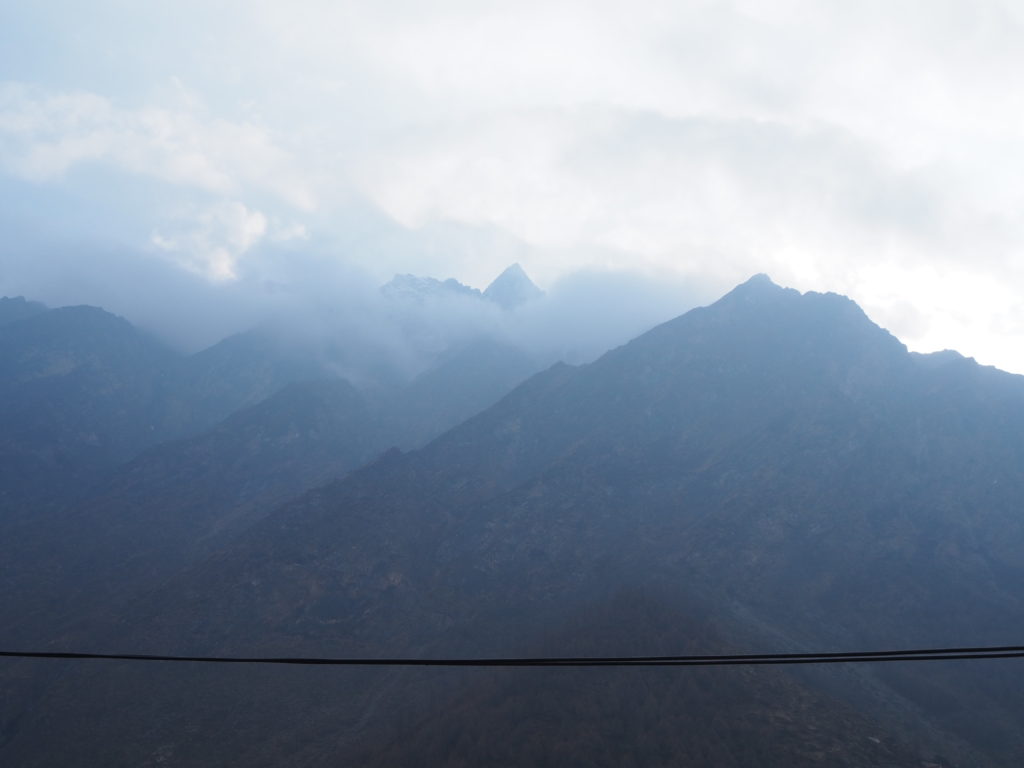


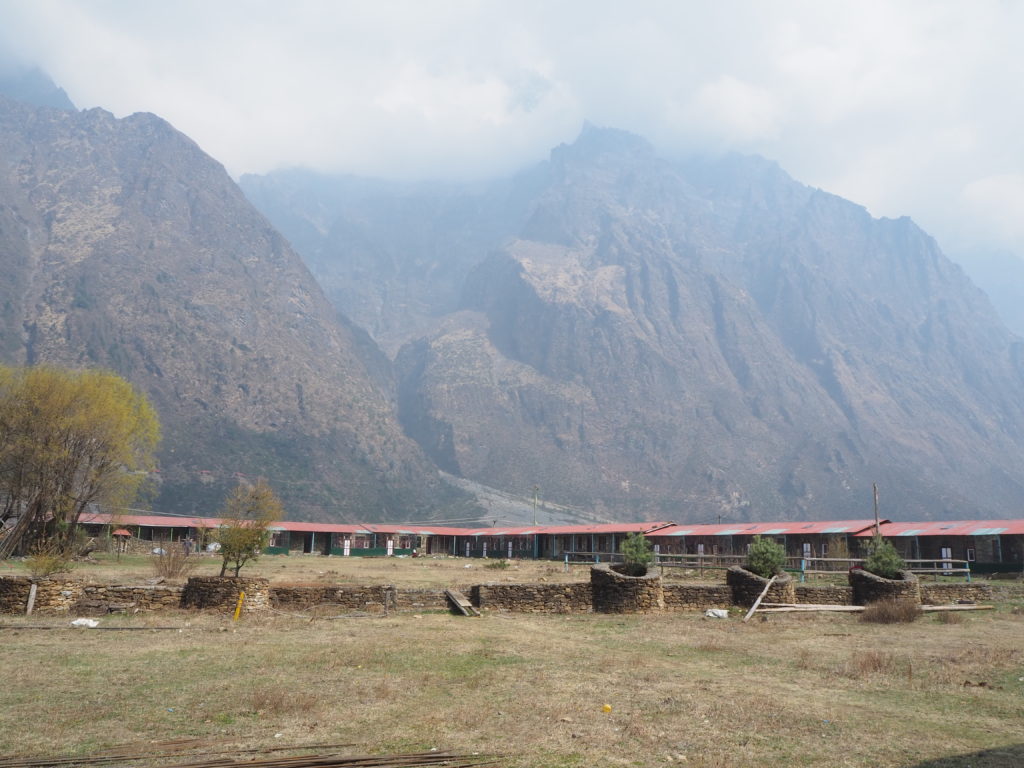
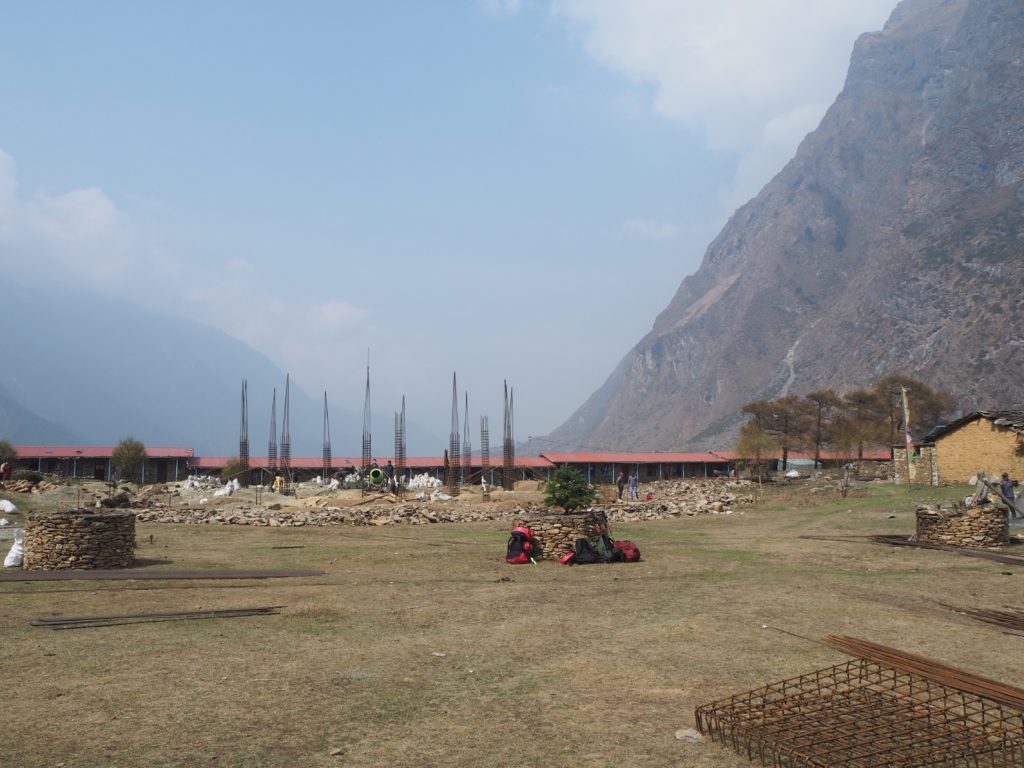
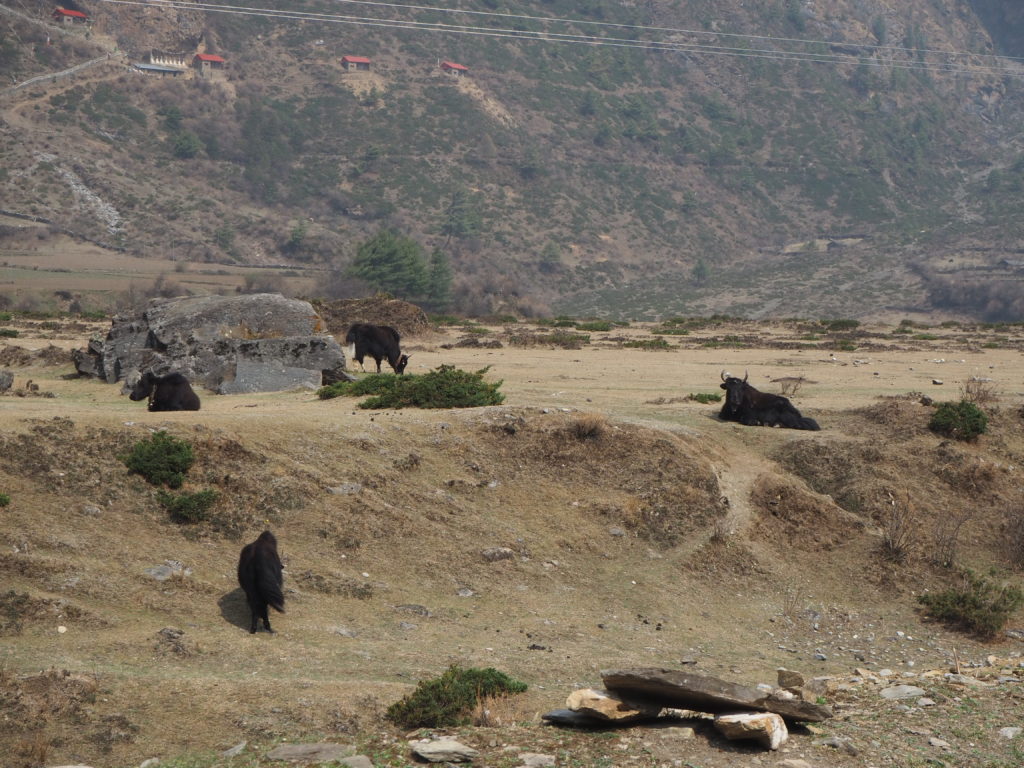


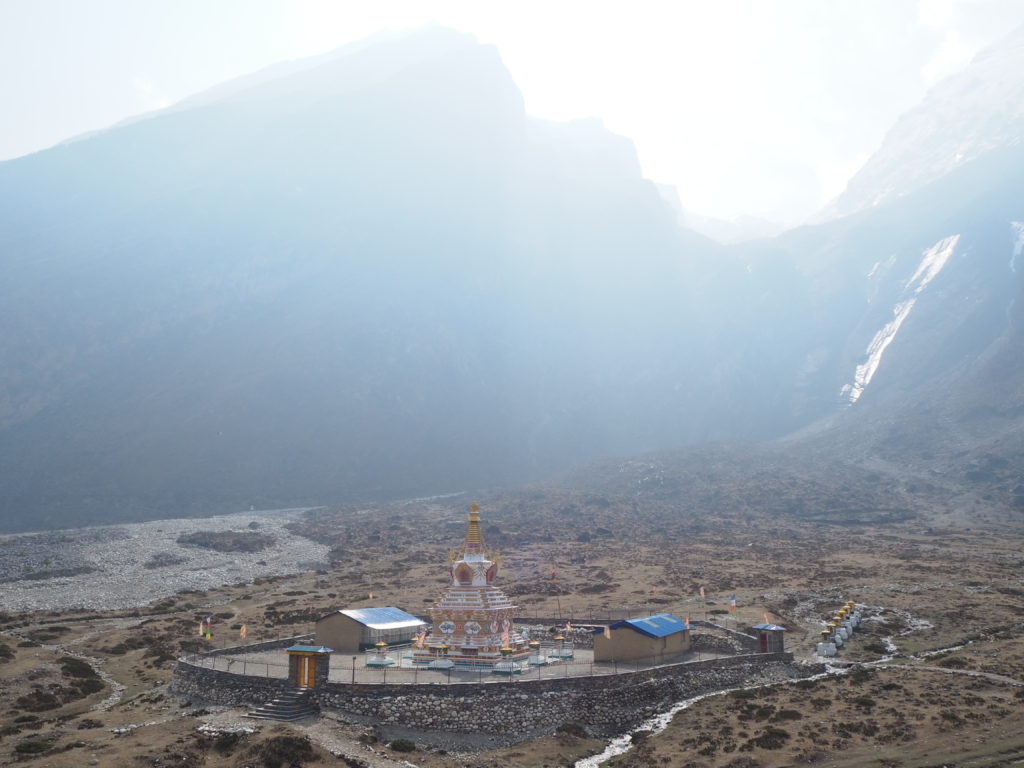
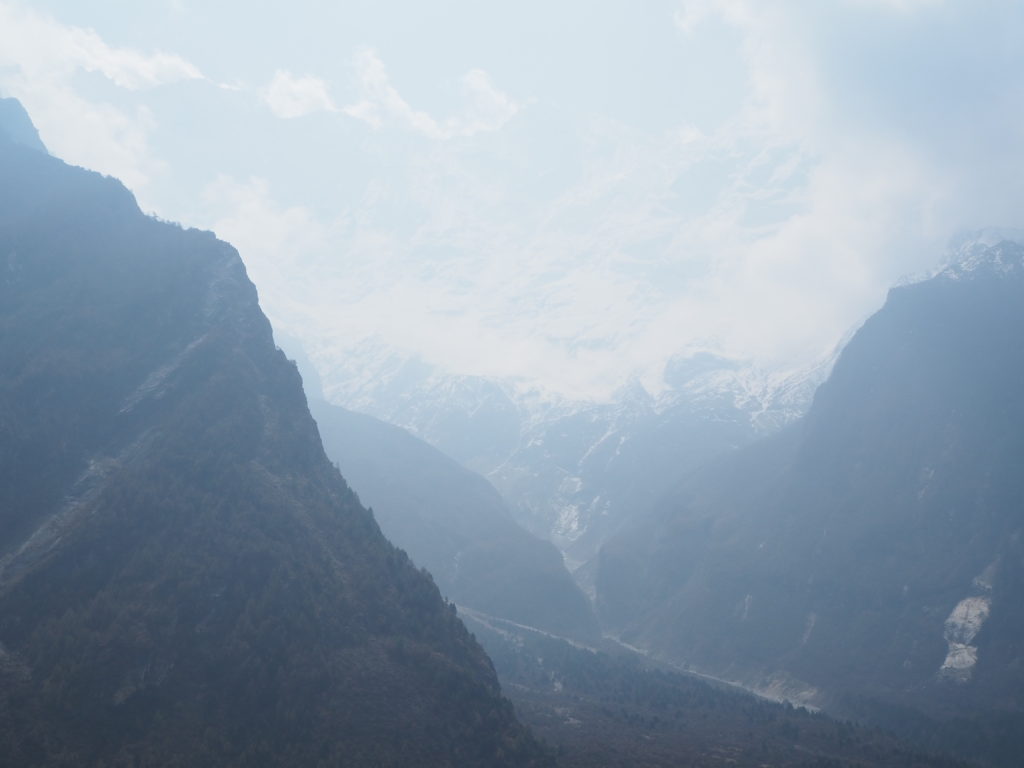
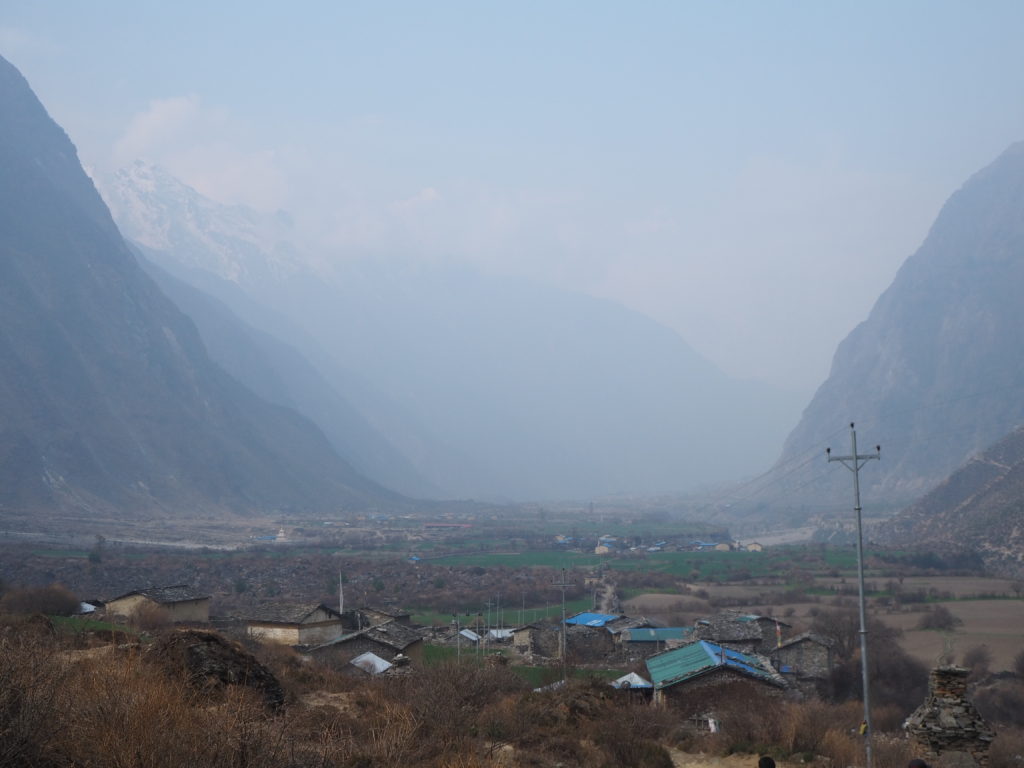

We only have a few more days in the Tsum valley, and they are supposed to be spectacular. Another nunnery, a base camp, and then finally, Manaslu for real. We will see you there


Obviously getting remote, off the beaten touristo path, good on yourselves. The monasteries are eye opening for a view of different culture and religion. Integrating well w the locals, kids and cattle. Life enriching, life affirming, keep it up.
Beautiful descriptive writing! This journey sounds so peaceful, but that doesn’t make it was easy. Good distractions with cows and kids! What a place to grow up!